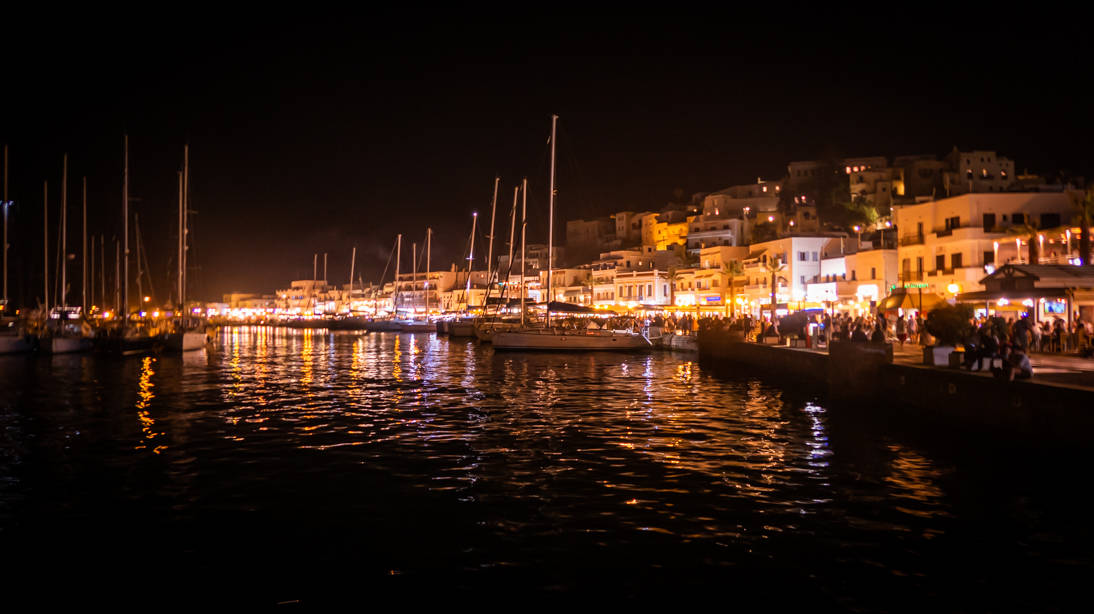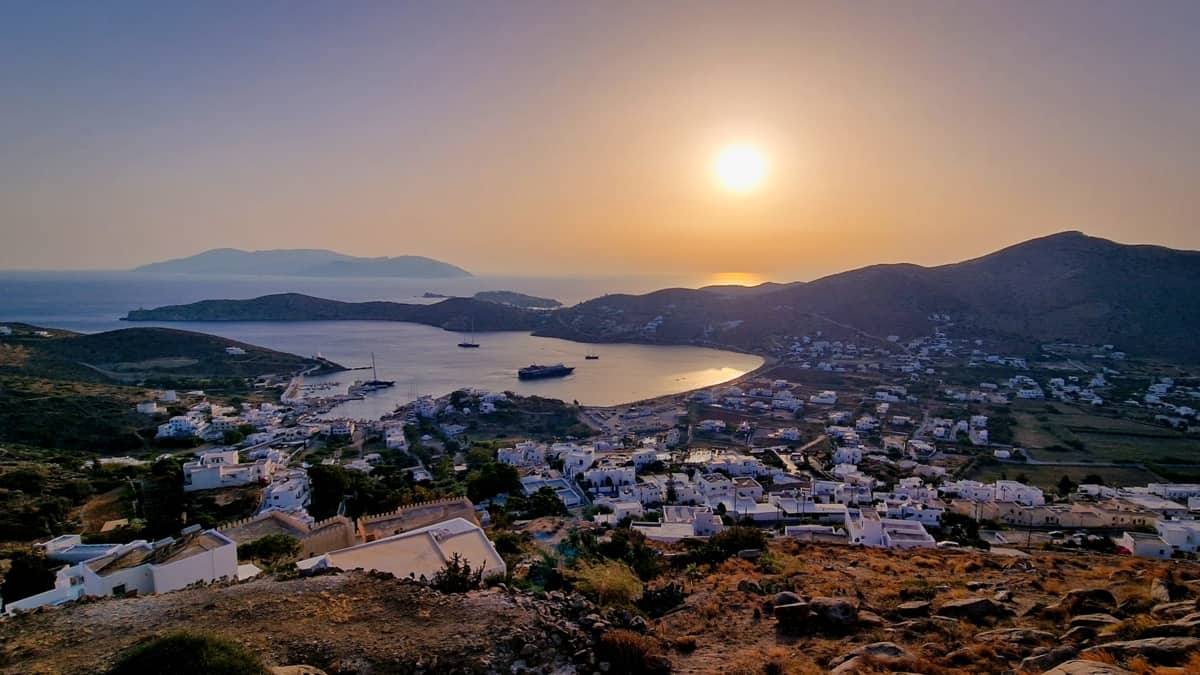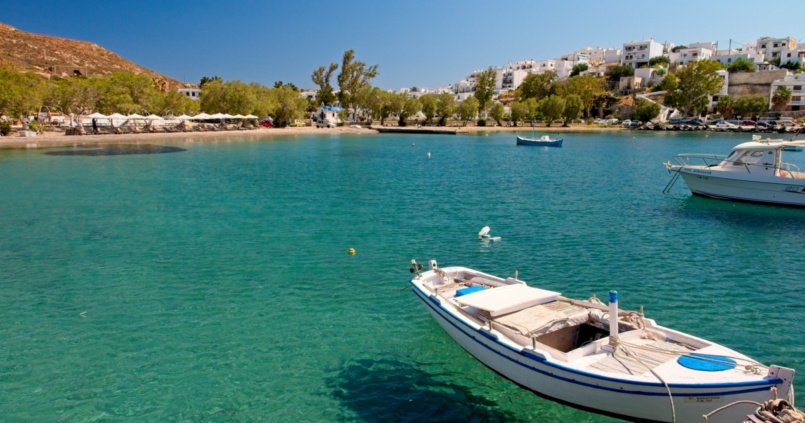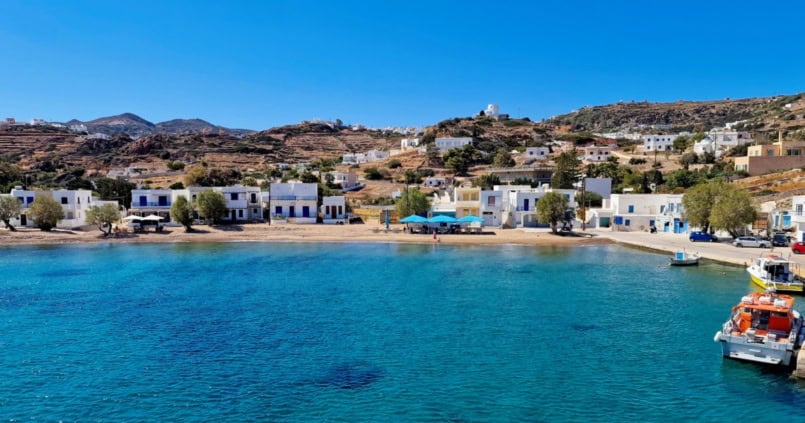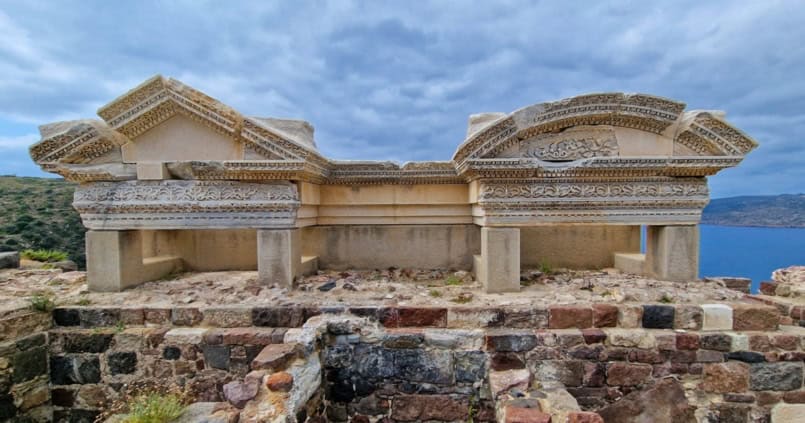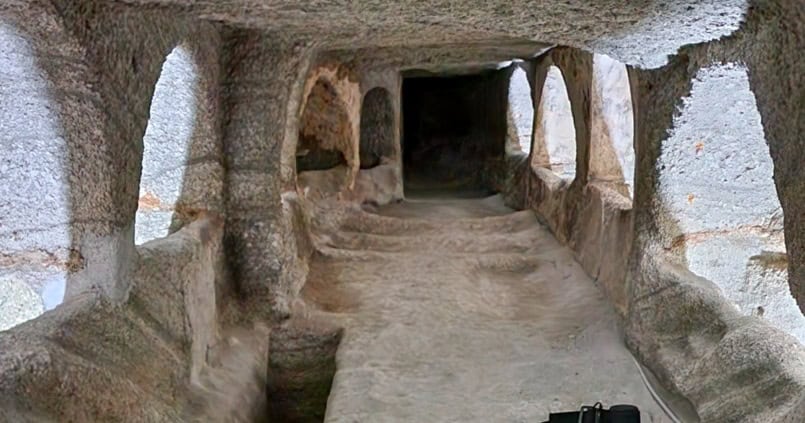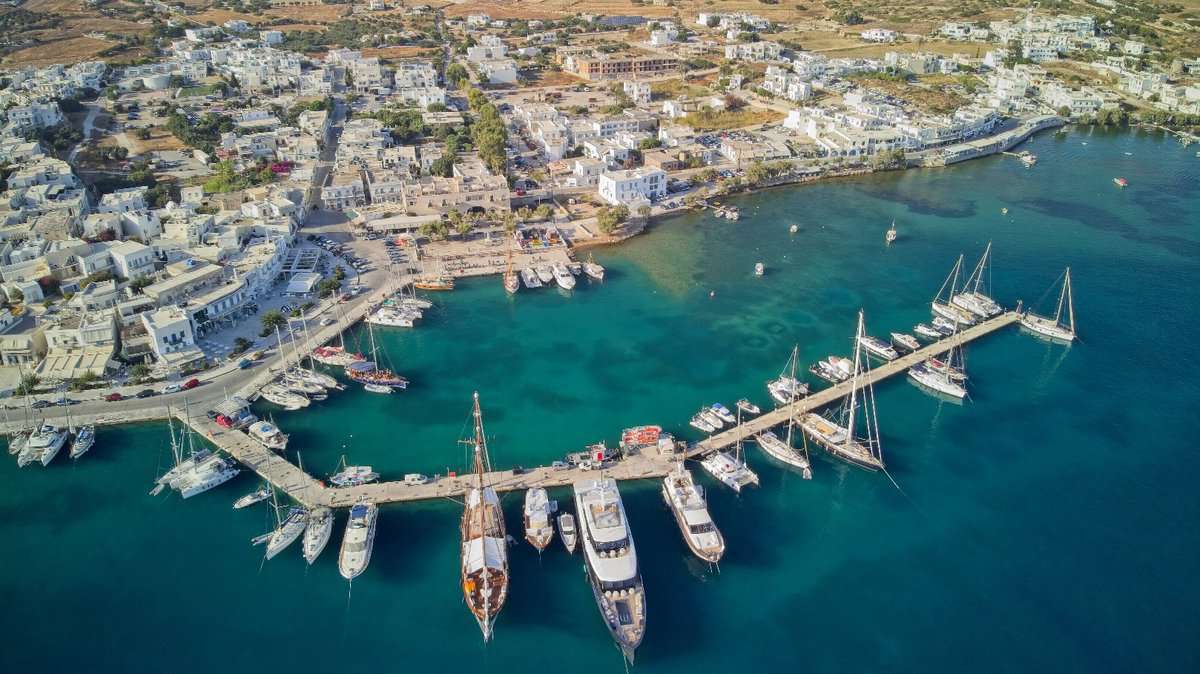
Milos Island Guide
Introduction to Milos
Known for its stunning coastline, colourful villages, and rich history, Milos is a true treasure of the Cyclades. This volcanic island boasts over 70 beaches, each offering something unique—from the lunar-like landscape of Sarakiniko to the crystal-clear waters of Firiplaka. Beyond its natural beauty, Milos charms visitors with its traditional fishing villages like Klima, vibrant local culture, and welcoming atmosphere. Whether you’re seeking adventure, relaxation, or a taste of authentic Greek island life, Milos promises an unforgettable experience away from the crowds.
Short on time? Click here for a quick summary…
- Getting there: Internal flights from Athens are faster, especially if you’re already at the airport. If not, or you’re on a tighter budget, take a ferry from Piraeus.
- When to visit: May-June or late September for fewer crowds. July-August for peak summer sun.
- Where to stay: Adamantas (Adamas) for a central location ideal for sightseeing. Pollonia for a quieter or more romantic break.
- Best activity: take a boat tour around Milos.
- Best beaches: Sarakiniko for its unique rock formation, Firiplaka for golden sand and clear water.
Want more details? Continue reading our full guide below.
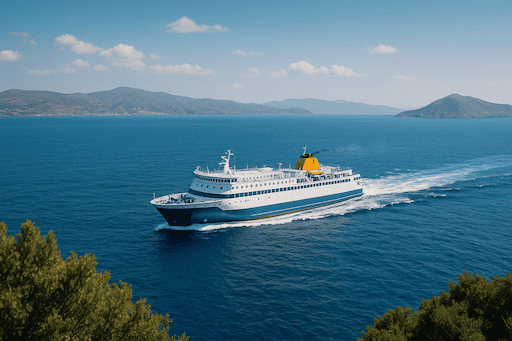
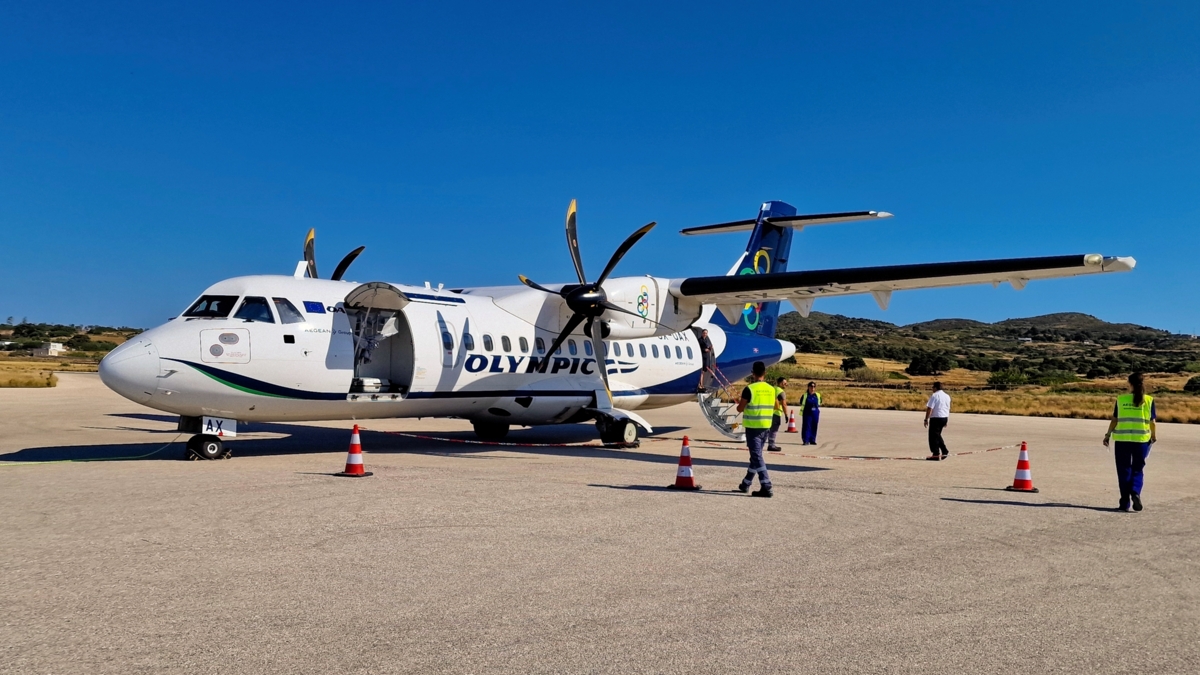

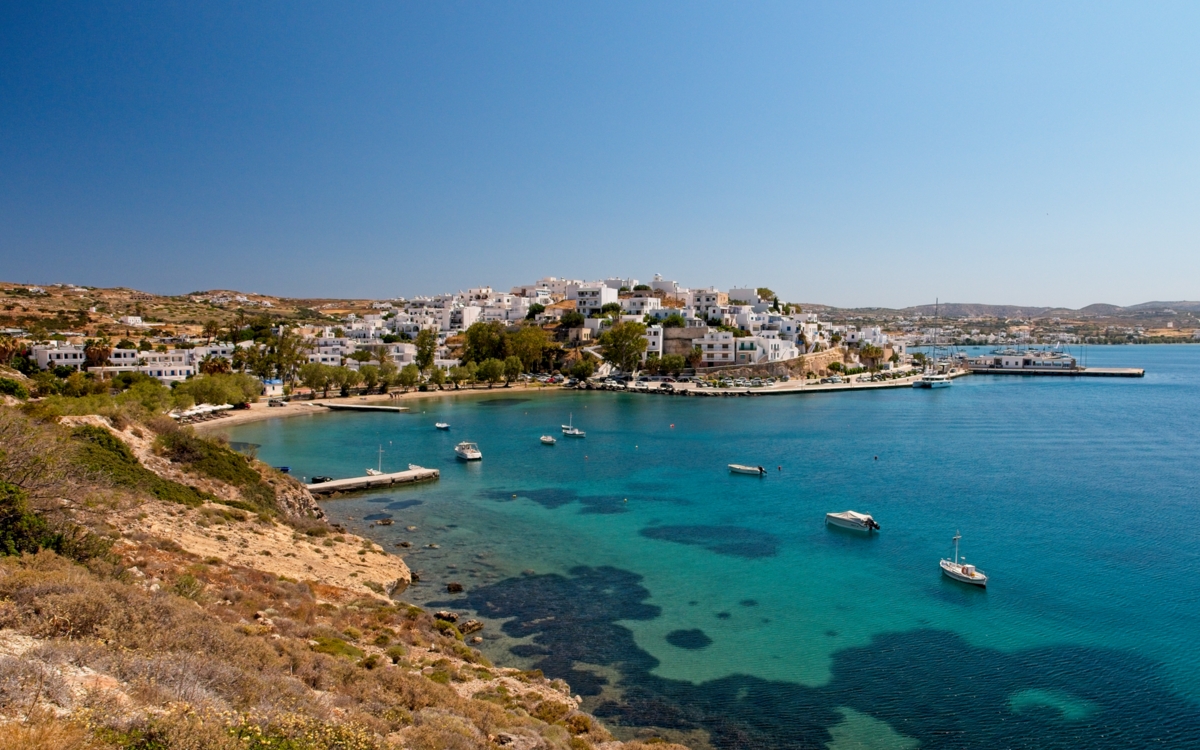
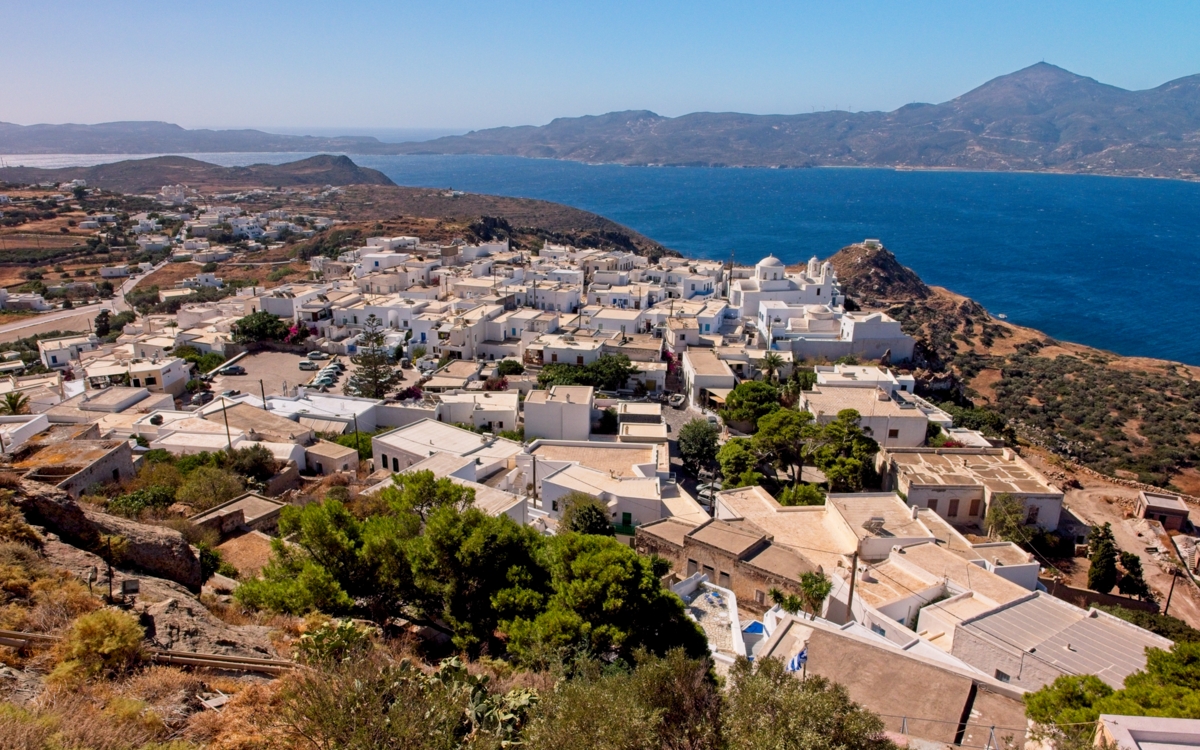
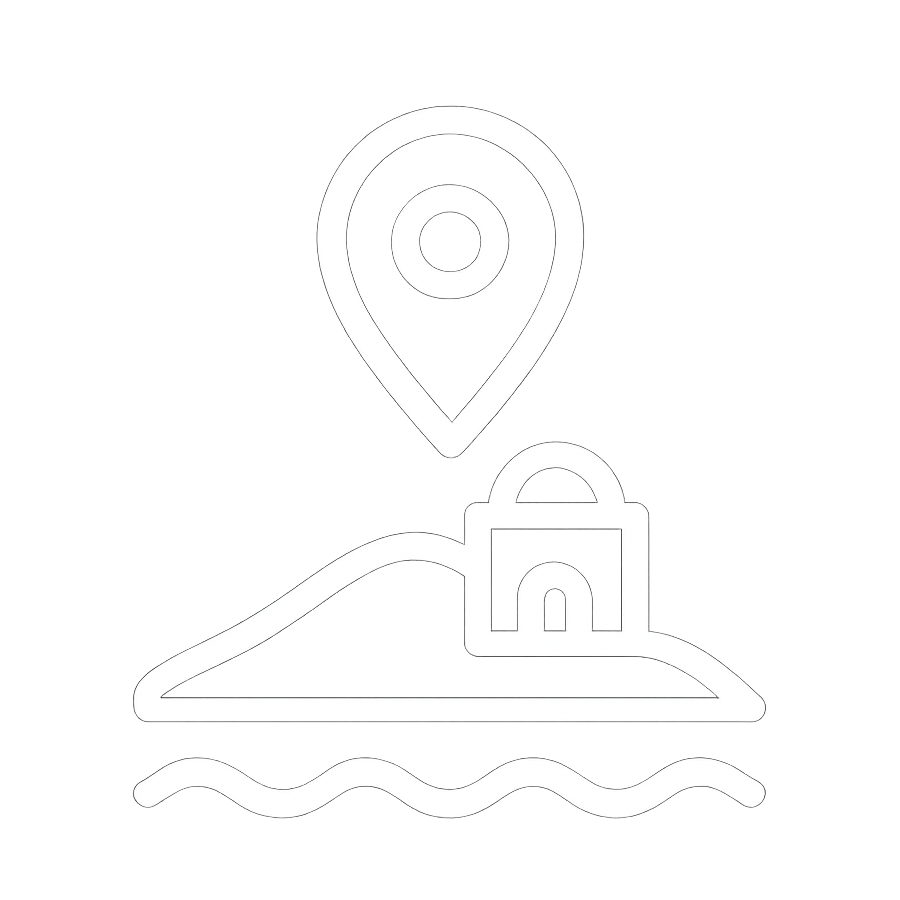
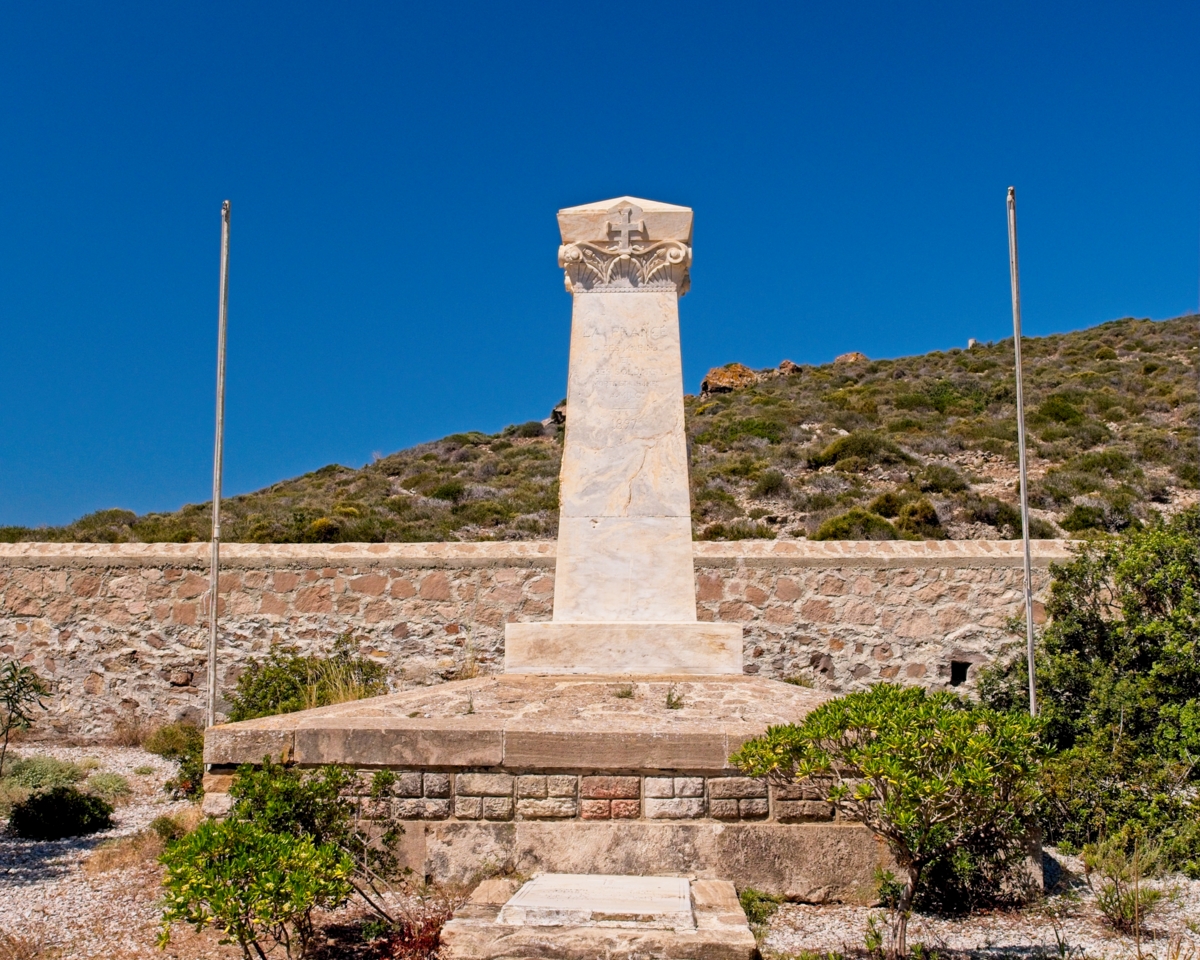
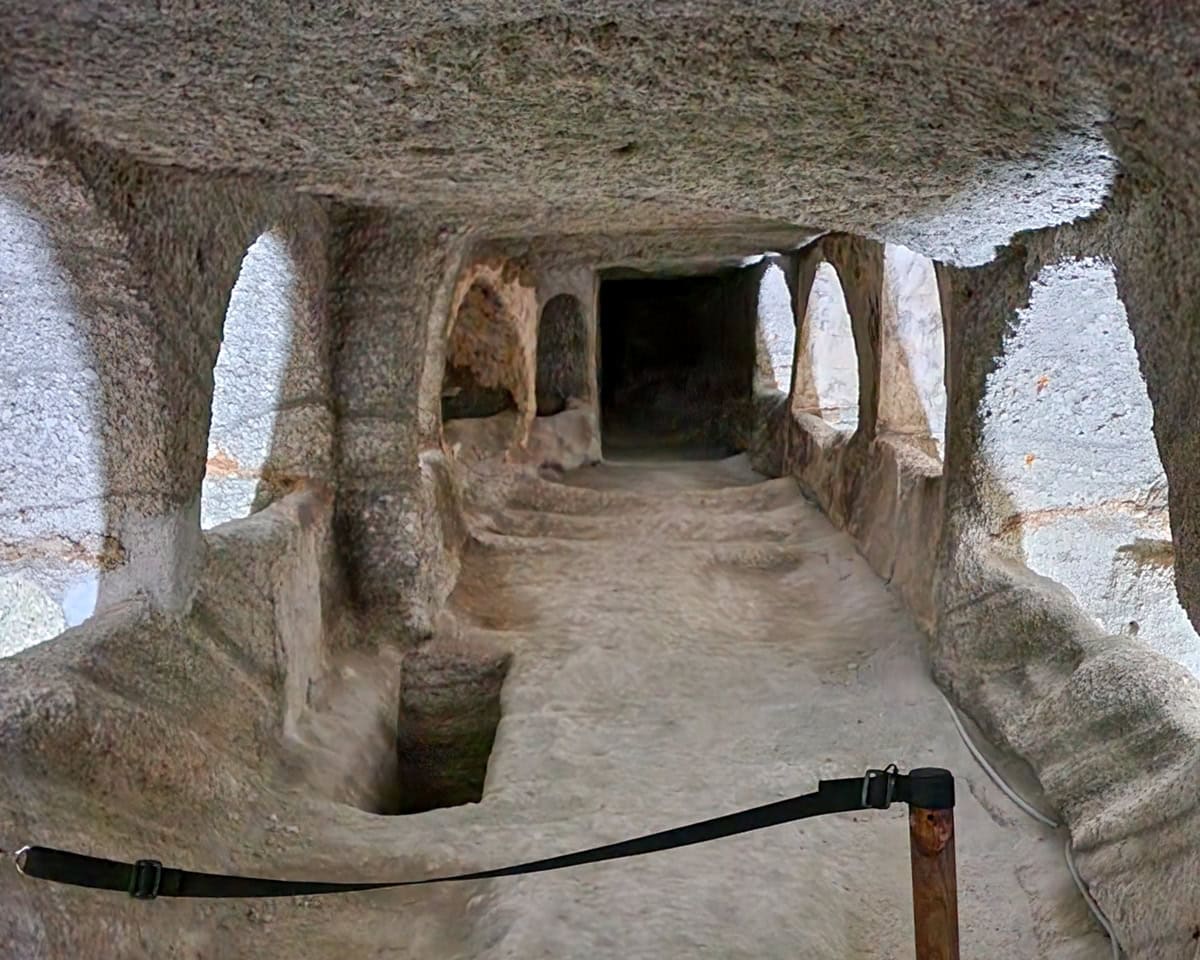

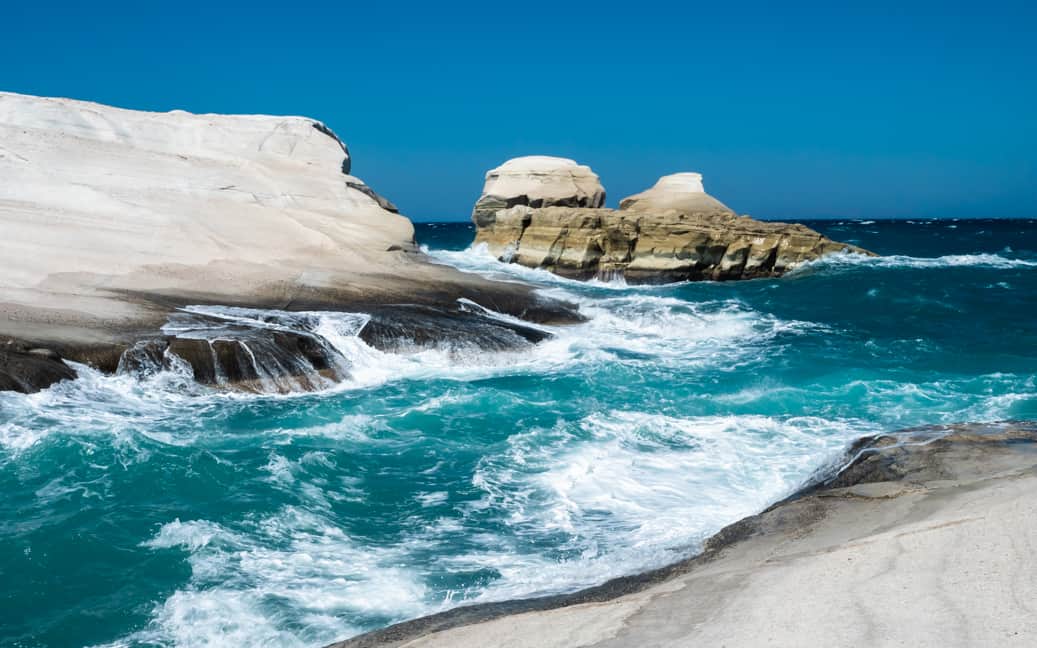
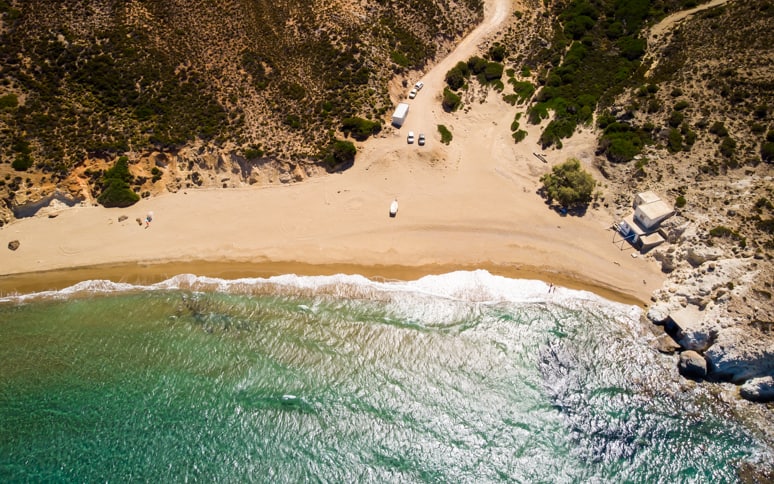

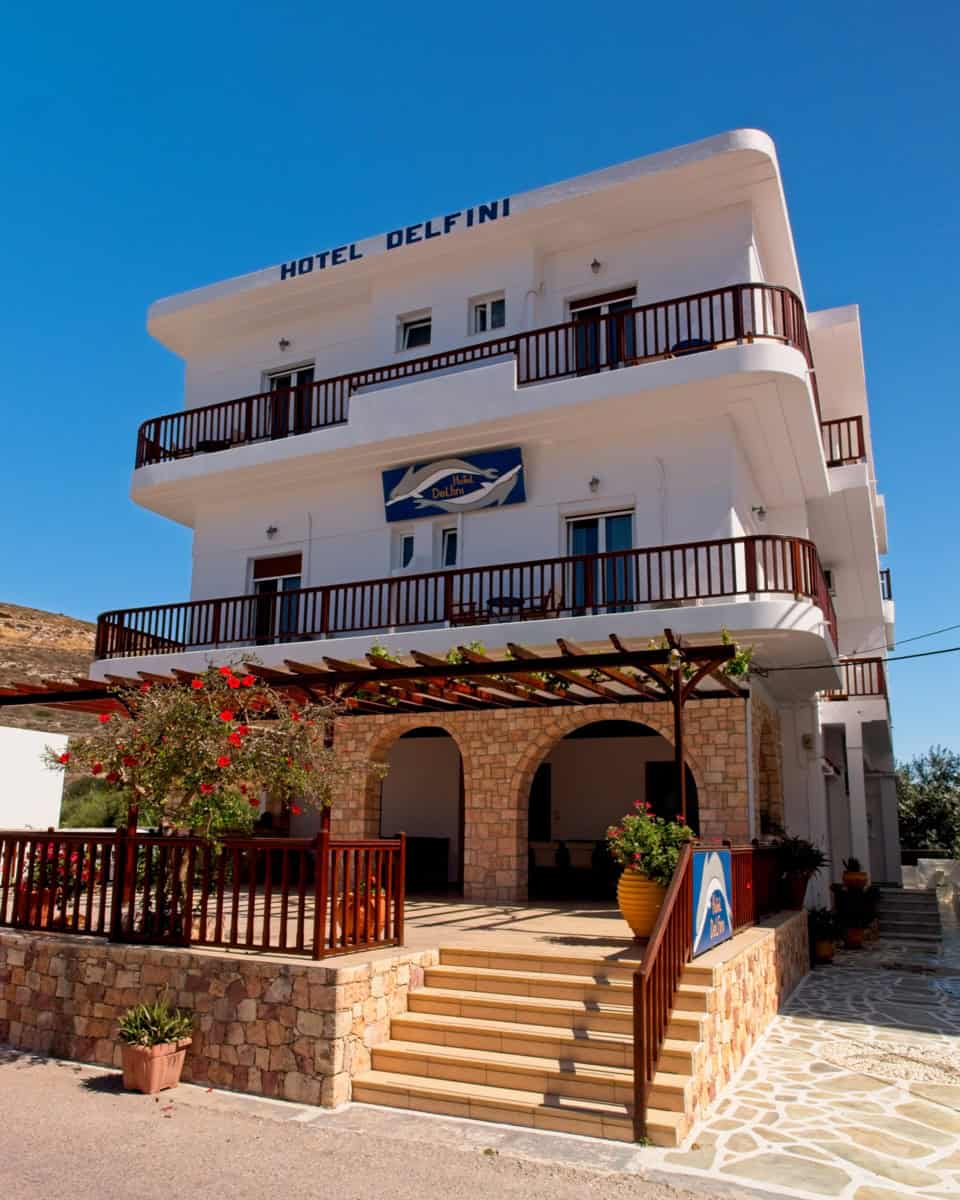
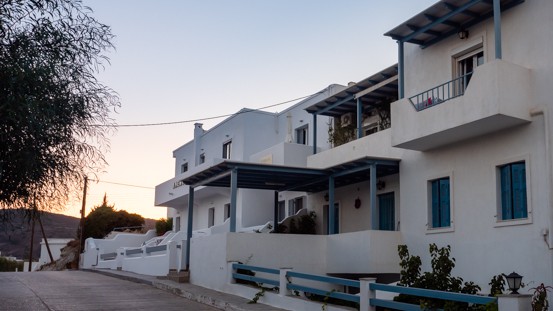




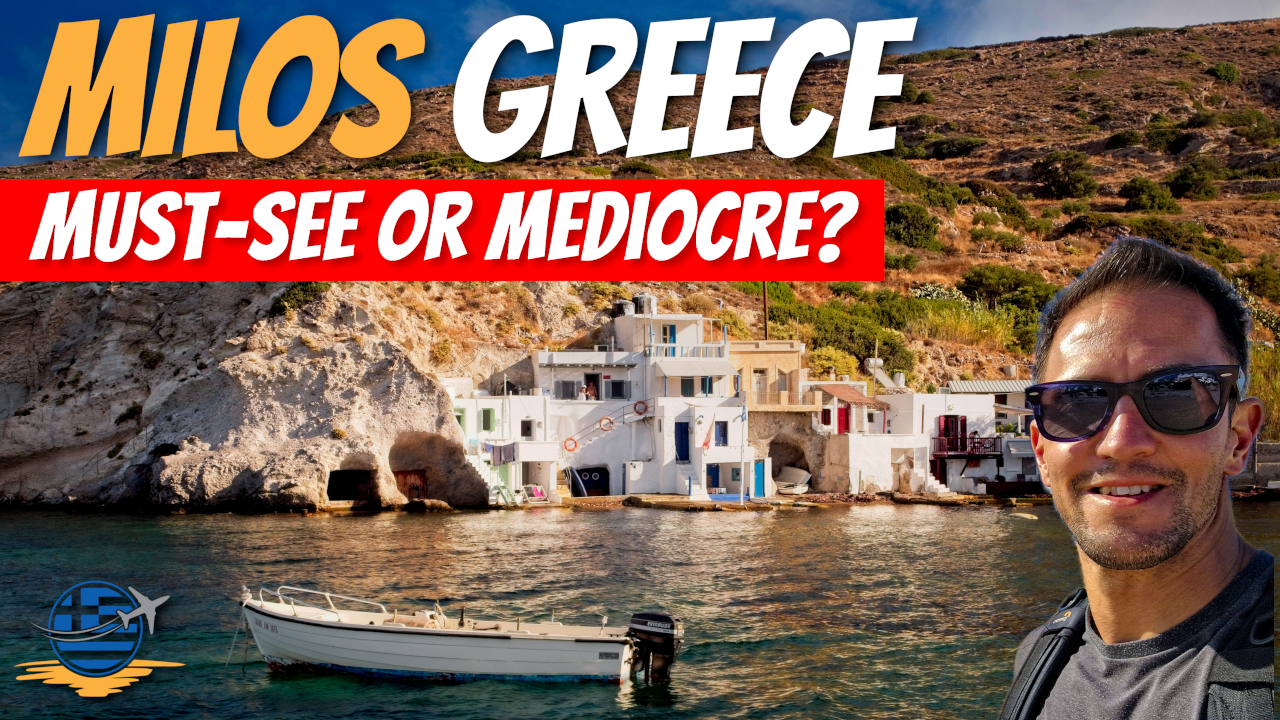





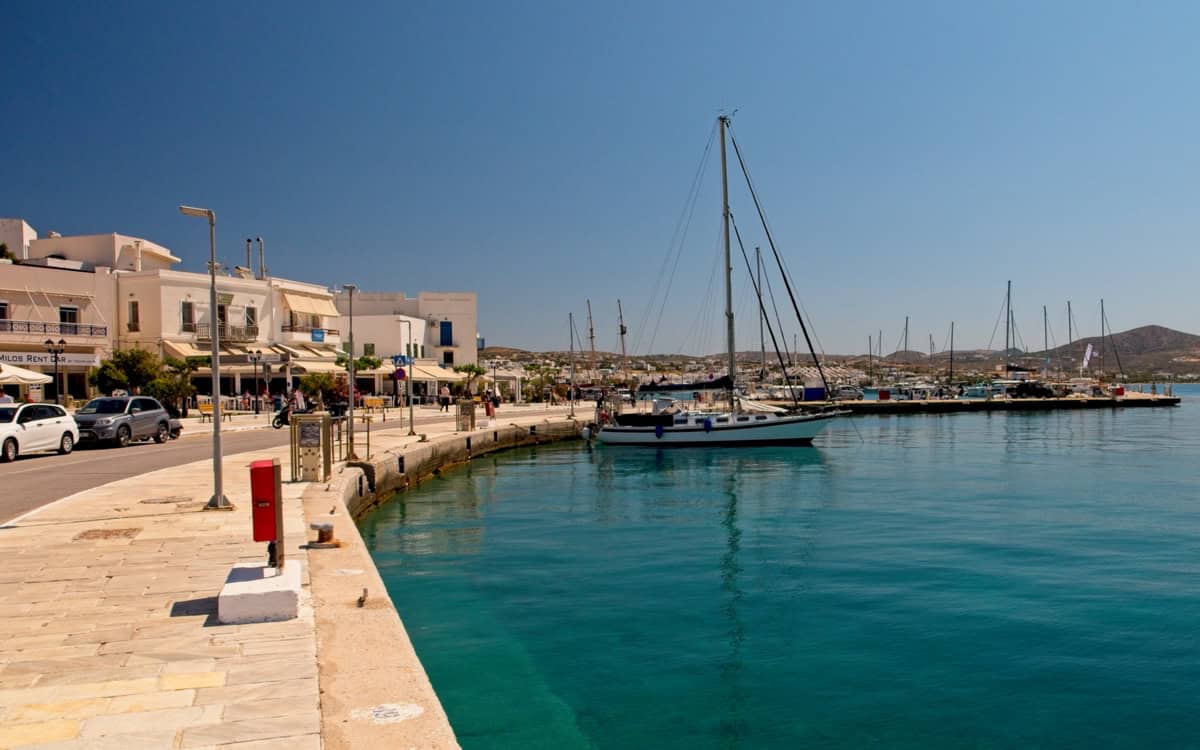


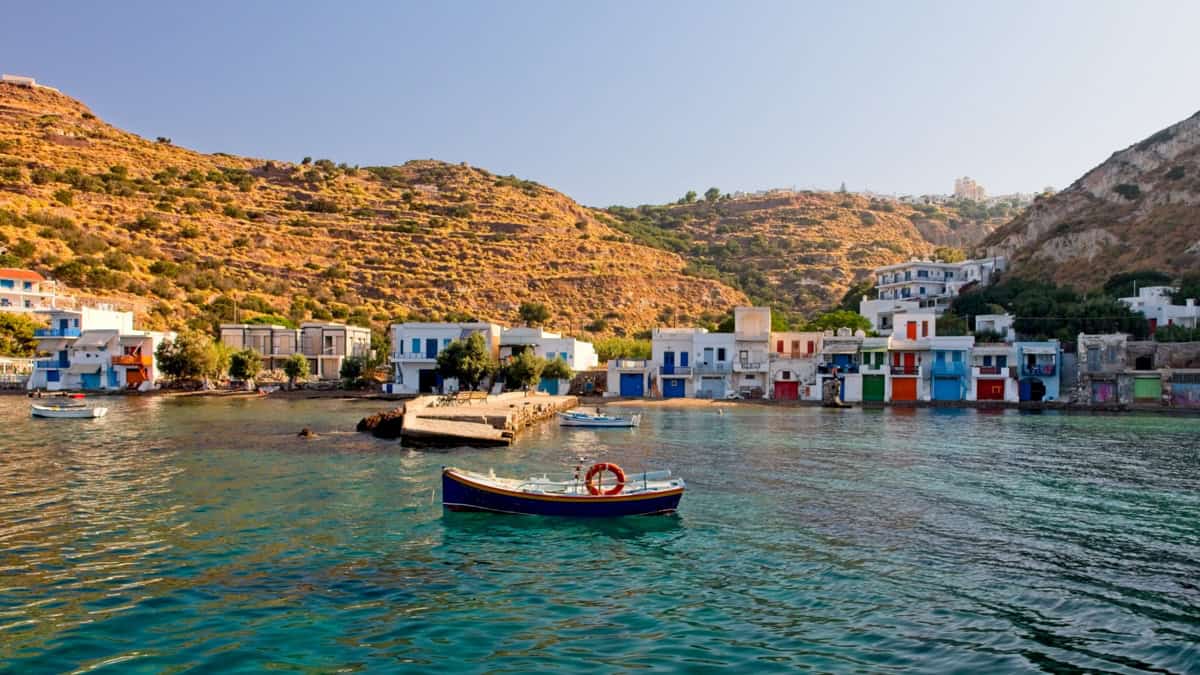


Getting to Milos
Milos is the most southwesterly island in the Cyclades, a popular group of islands in the centre of Greece, including well-known destinations such as Mykonos, Paros and Santorini.
By Plane
The fastest way to reach Milos is by domestic flight from Athens. Ticket prices range from €50 to €150, depending on the time of year and availability. It’s a convenient option and our preferred way to arrive, but remember to check baggage size and weight restrictions when you book, as limits can be lower on internal flights. We recommend Skyscanner for flight bookings.

Flights take just 30 minutes (barely enough time to reach cruising altitude!), and Milos airport is just 10 minutes by car or taxi from the main port town of Adamantas. A bus service connects the port to the airport during high season. You can find the Milos bus timetable here.
By Ferry
If you prefer travelling by sea, ferries from Piraeus offer a scenic alternative. The journey takes between two and a half and six hours, and tickets cost between €40 and €80. Milos is also well-connected to nearby islands such as Sifnos, Folegandros, and Santorini, making it perfect for island hopping.
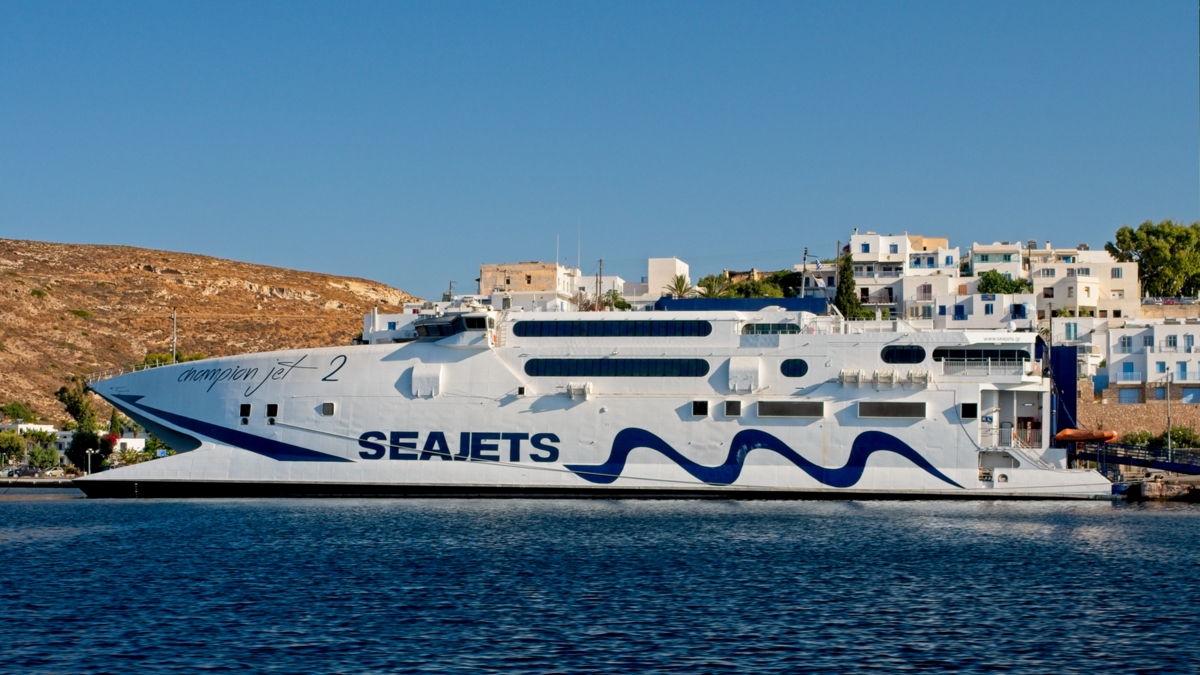
High-speed ferries provide faster transfers, though prices have risen significantly in recent years, in some cases making them more expensive than internal flights. To save money, consider taking slower conventional ferries instead. However, these don’t run daily, so be sure to plan accordingly. Use the FerryHopper search box below to compare ticket prices and plan your itinerary.
Be aware that routes for the summer season aren’t always confirmed until March-April of each calendar year, so if you don’t see availability for your chosen dates, it may be too early. You’ll need to check back again later.
Where to Stay in Milos
Milos has two main tourist villages: Adamantas (sometimes known as Adamas) and Pollonia.
Adamantas, the port town, is the heart of tourist activity on the island. Situated in the large, sheltered gulf formed by the island’s volcanic history, the village stretches from Lagada Beach in the west to Papikinou Beach in the east. Adamantas offers a wide range of accommodation to suit most budgets, including hotels, studios, and apartments. The picturesque harbour buzzes with the comings and goings of ferries and small boats. By evening, it transforms into a lively hotspot with numerous tavernas, cafes, and bars perfect for dining and entertainment. We chose Adamantas as our base during both visits to Milos due to its unbeatable convenience, proximity to sandy beaches, and easy access to local villages and sightseeing opportunities, which we’ll cover later.
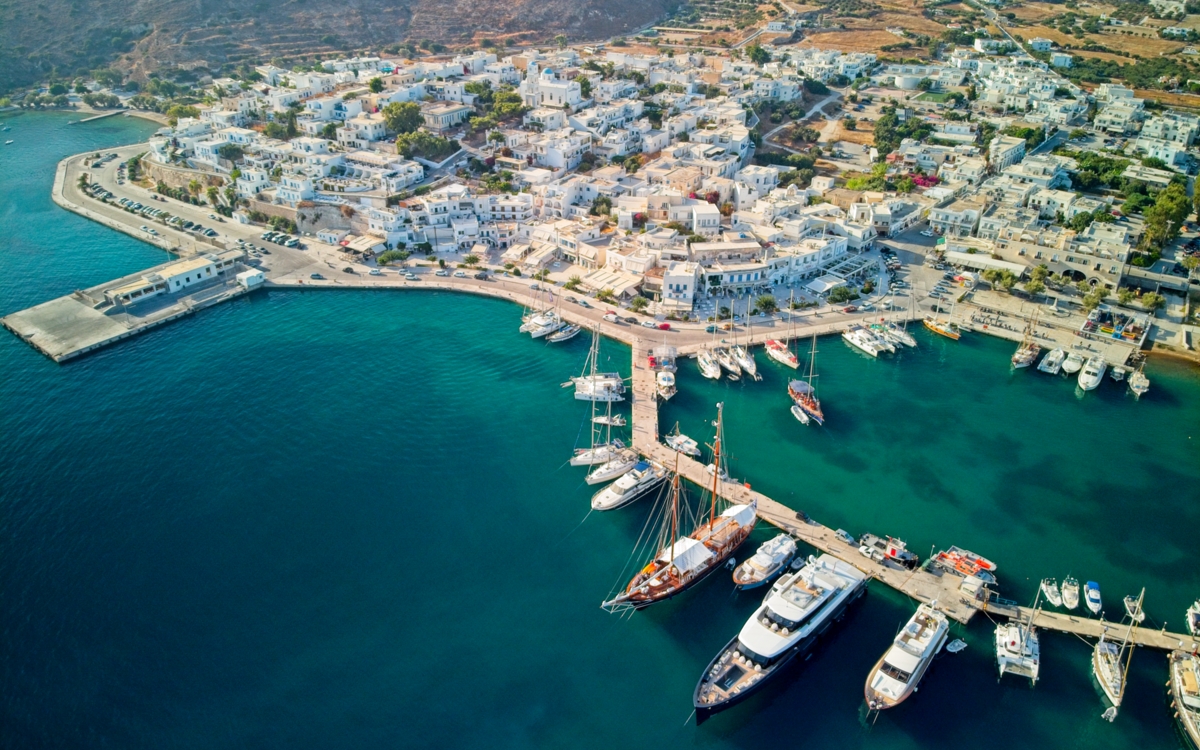
Pollonia is a charming fishing village nestled on the northeastern tip of the island. Its beautiful setting, with a spacious beach and a delightful array of restaurants and cafes near the small harbour, makes it a favoured spot for visitors looking for a more relaxed base. Accommodation options here range from cosy, budget-friendly rooms to luxurious suites. Just a 15-minute drive from Adamantas, Pollonia is also connected by a regular bus service during the main tourist season from late May to early October. If you plan to visit the neighbouring island of Kimolos, Pollonia is where the small ferry departs, so it could be the ideal place to stay.
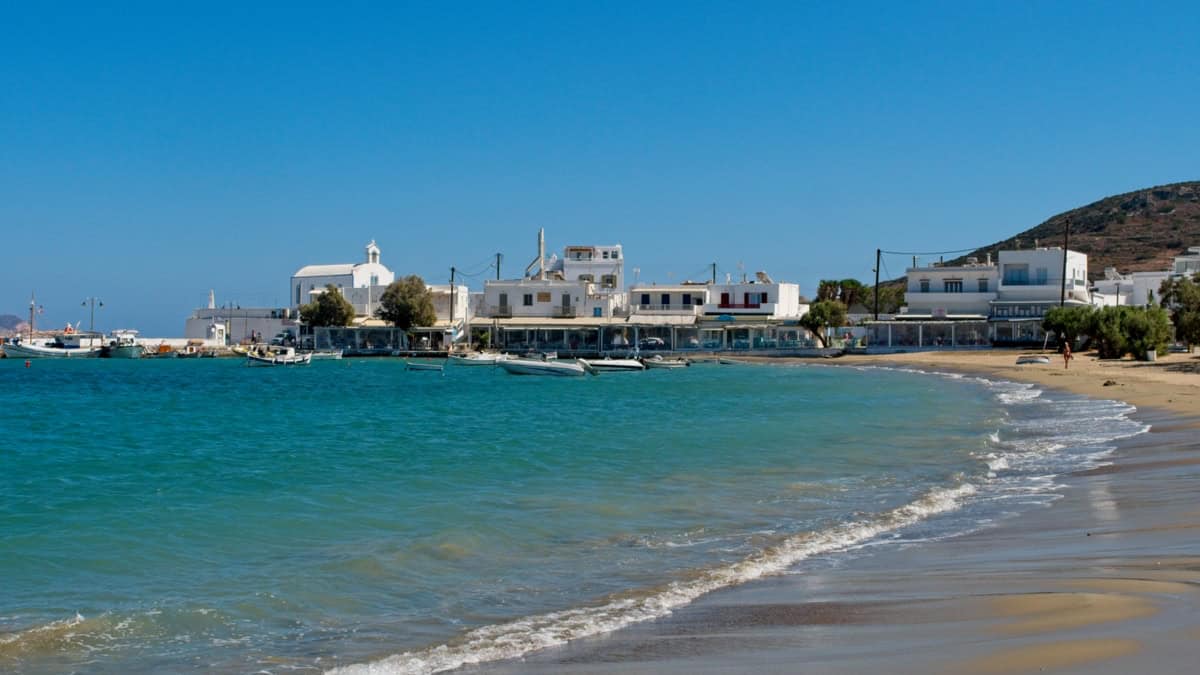
For those seeking a more traditional experience, the northwestern villages of Trypiti, Triovasalos, and the capital, Plaka, offer alternative accommodation options. These quaint villages provide an opportunity to experience the island’s authentic charm away from the more tourist-centric resorts.

Getting Around Milos
Despite its popularity, public transport on Milos is not as comprehensive as you might find on other islands such as Sifnos or Paros. Most villages are accessible by bus, but you need to carefully plan your itinerary around the schedules to maximise sightseeing time. The Milos bus timetable is online here.
If you want to explore Milos thoroughly, it’s worth hiring a vehicle for a day or two, which is plenty of time to see everything the island has to offer. On our recent visit in May 2024, we hired an e-bike for two days for €45 and found it a convenient and eco-friendly way of exploring the island. It’s also free to take bikes across to Kimolos on the small ferry–more on this later.
Given Milos’ small size, most villages and attractions are within a short 15-20 minute journey, so you don’t need to plan too extensively to explore the island – you can easily drive around and let the sights unfold around you.
Be aware that most of Western Milos beyond Achivadolimni Beach is barren and uninhabited. The road network is poor, and most rental companies will not allow you to take normal cars there, so if you want to visit this side of the island, you’ll need to hire a 4×4 or ATV. Having explored western Milos on our first trip in 2020, we wouldn’t recommend it. There’s really not much to see, and the road conditions made it rather unpleasant, even on a large quad bike. Taking a boat tour around the island is a better option, which we’ll discuss in the next section.
Things to do in Milos
There are several sightseeing opportunities on Milos. In this section, we’ll discuss some of the more popular attractions worth including during your stay.
Sarakiniko Beach
This unique beach is by far the most popular attraction on Milos. Famous for its smooth, white rock formations resembling the Moon’s surface, it’s one of the Cyclades’ most photographed and iconic sights. Created by volcanic activity, the rocks have been eroded by the wind and sea over thousands of years, resulting in the vivid, smoothly undulating terrain visible today. The dramatic rock formations plunge deep into the water, creating a popular spot for cliff diving and swimming. However, on both occasions we visited Sarakiniko, the strong winds made the sea very rough and the water too dangerous to enter.
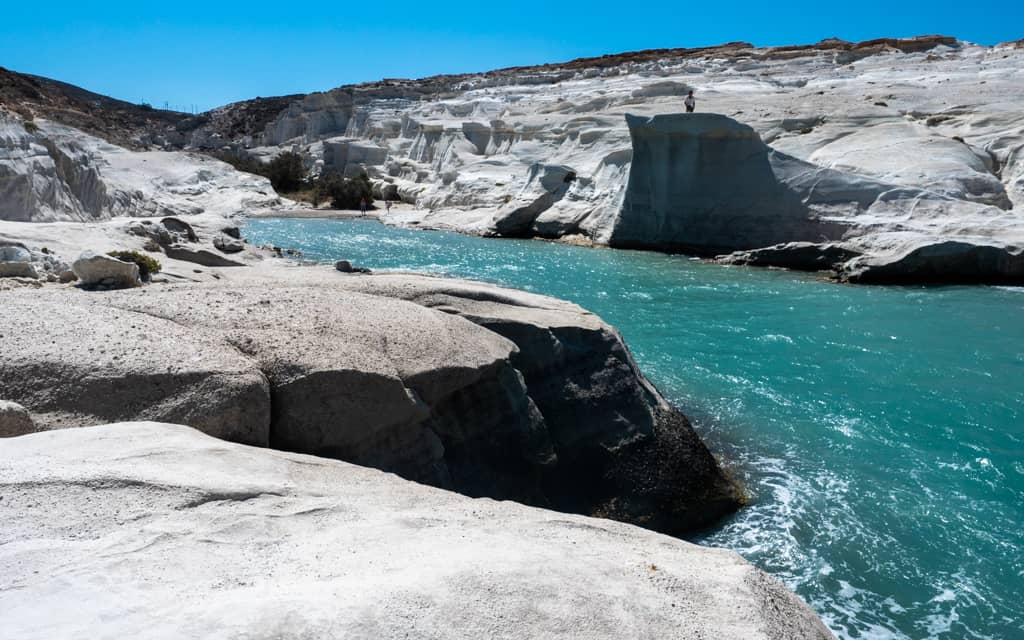
Despite its popularity, the actual sandy beach area is disappointingly small, so unless you find it comfortable laying on solid rock, it’s not somewhere we’d want to spend more than a couple of hours. Its popularity also draws large crowds, and there is a lack of natural shade and food and drink facilities, so we recommend keeping your visit short and finding a nicer beach if you want to sunbathe and relax.
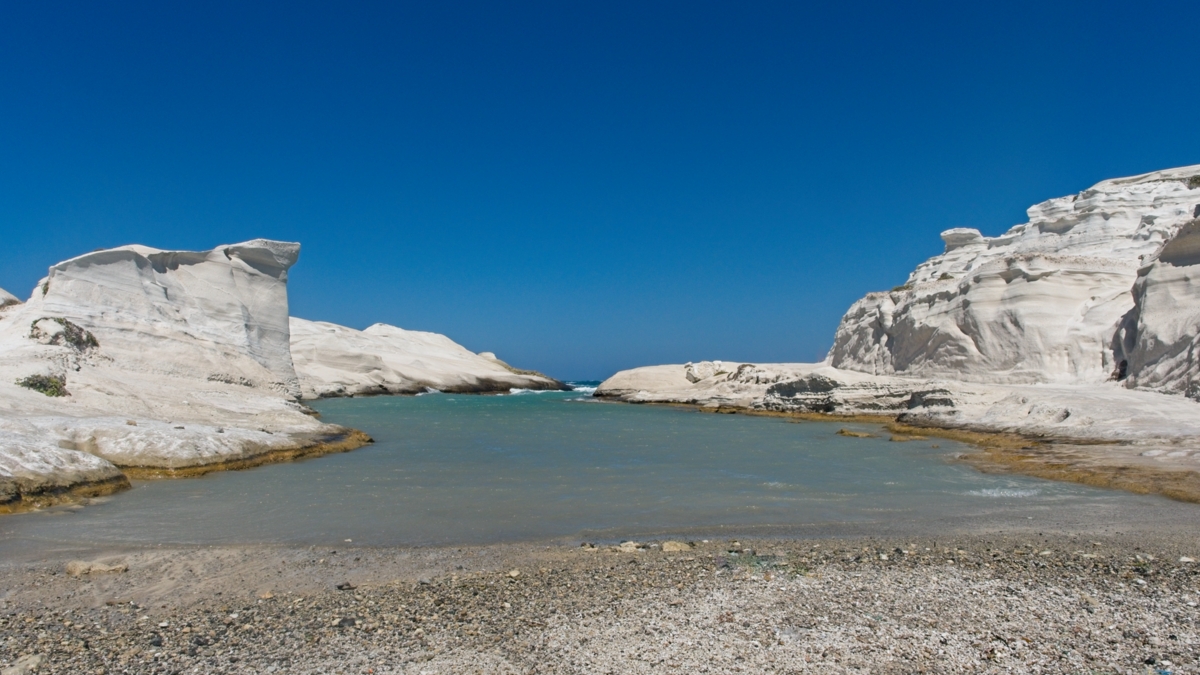
Catacombs of Milos
The Catacombs of Milos are among Greece’s most significant and impressive early Christian sites. Located near the village of Tripiti, which is northwest of the port, they date back to the 1st century and served as a burial site and place of worship during times of persecution.
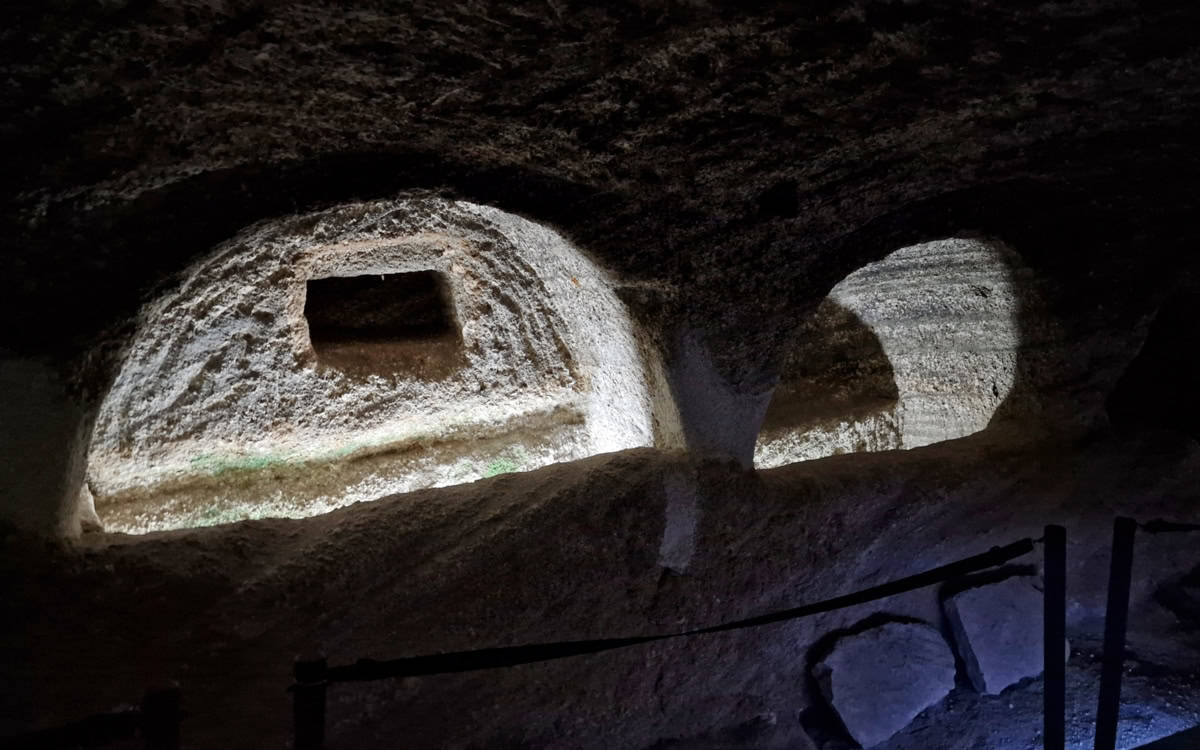
The catacombs consist of three main underground chambers, totalling around 185 meters in length. They contain numerous tombs carved into the rock walls, some decorated with frescoes and inscriptions. Entry costs €4 and includes a guided tour. Although it only lasts 15 minutes, the tour provides lots of interesting information and is well worth it for an insight into the island’s fascinating past.
Ancient Theatre
The nearby Ancient Theatre of Milos is a significant archaeological site that highlights the island’s cultural heritage and rich history. Situated further down the hillside, just a short distance from the Catacombs, the theatre dates back to the Hellenistic period and features notable Roman modifications. Visitors can explore the theatre free of charge, and free parking is available at the Catacombs, just a few minutes walk away.
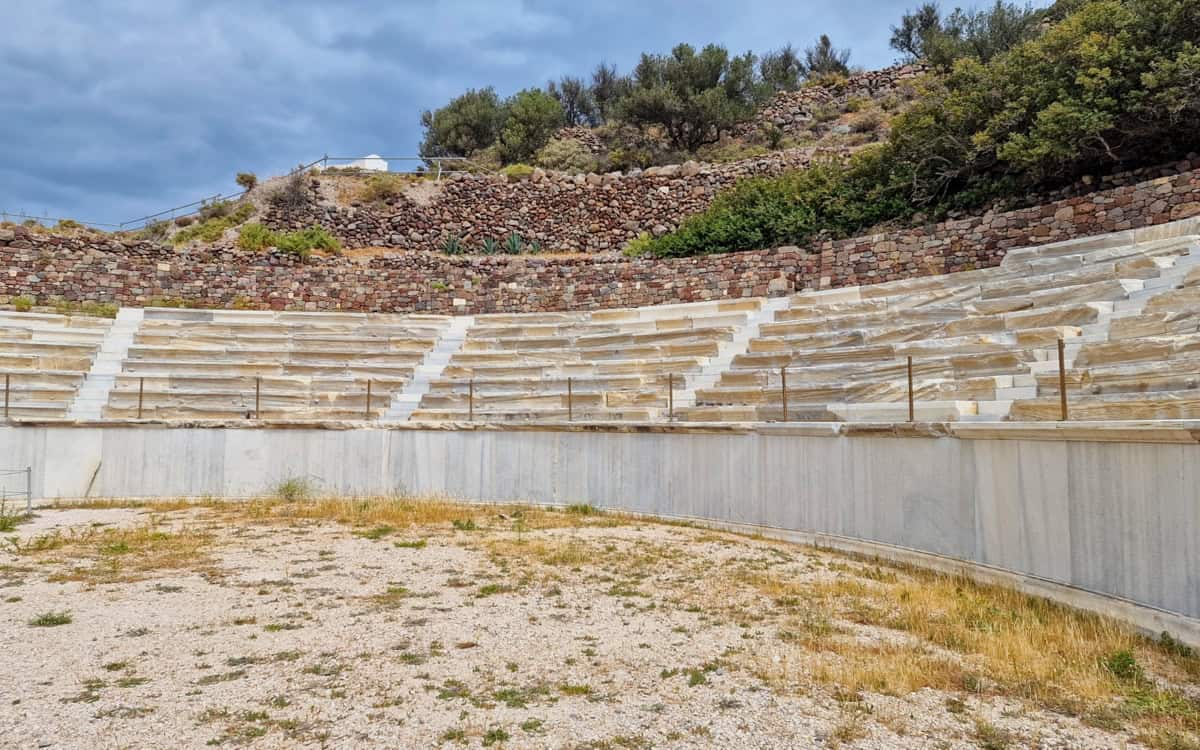
Plaka, Trypiti and Triovasalos
The island’s capital, Plaka, along with the neighbouring settlements of Trypiti and Triovasalos, is located inland, northwest of Adamantas, about a 10-minute drive away. These villages epitomise the whitewashed charm of Cycladic architecture, scattered across the sloping landscape and providing a picturesque view of Milos as a traditional Greek island. They offer an interesting contrast to the more tourist-centric resorts of Pollonia and Adamantas and are well worth exploring. Notably, the views from Plaka Castle and its numerous churches perched at the summit are breathtaking, offering a captivating panoramic vista of the entire island.
Plaka and Trypiti are also popular spots to catch the impressive sunsets Milos can offer on clear summer evenings.
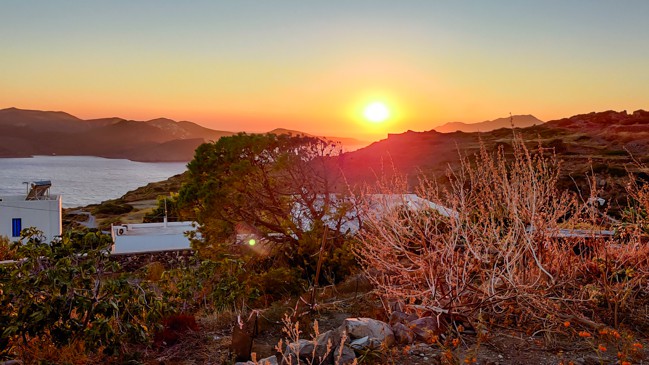
Klima, Firopotamos and Mandrakia
Several quaint fishing villages are dotted around the island’s rugged coastline. Klima is the most famous of these, with its iconic colourful waterfront boat houses, known as Syrmata, some of which have been converted into intimate rental properties, although their precarious proximity to the water’s edge and abundant aroma of seaweed doesn’t seem very romantic to us!

Firpotamos and Mandrakia are on the opposite coastline, north and east of Plaka. The former is a tiny picturesque village with a few small apartments and a sandy beach that is prone to wavy seas due to its north-facing position.
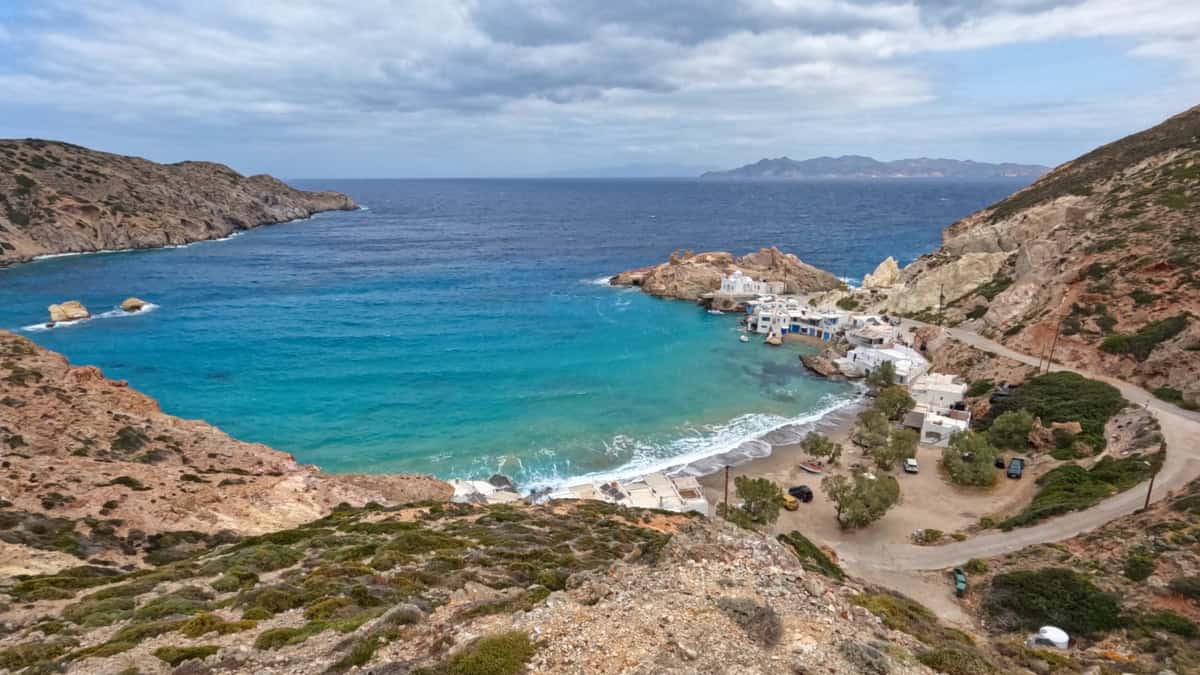
Mandrakia is equally small and quaint but more popular due to its pretty, sheltered marina and more dramatic setting, which offers plenty of photo opportunities.
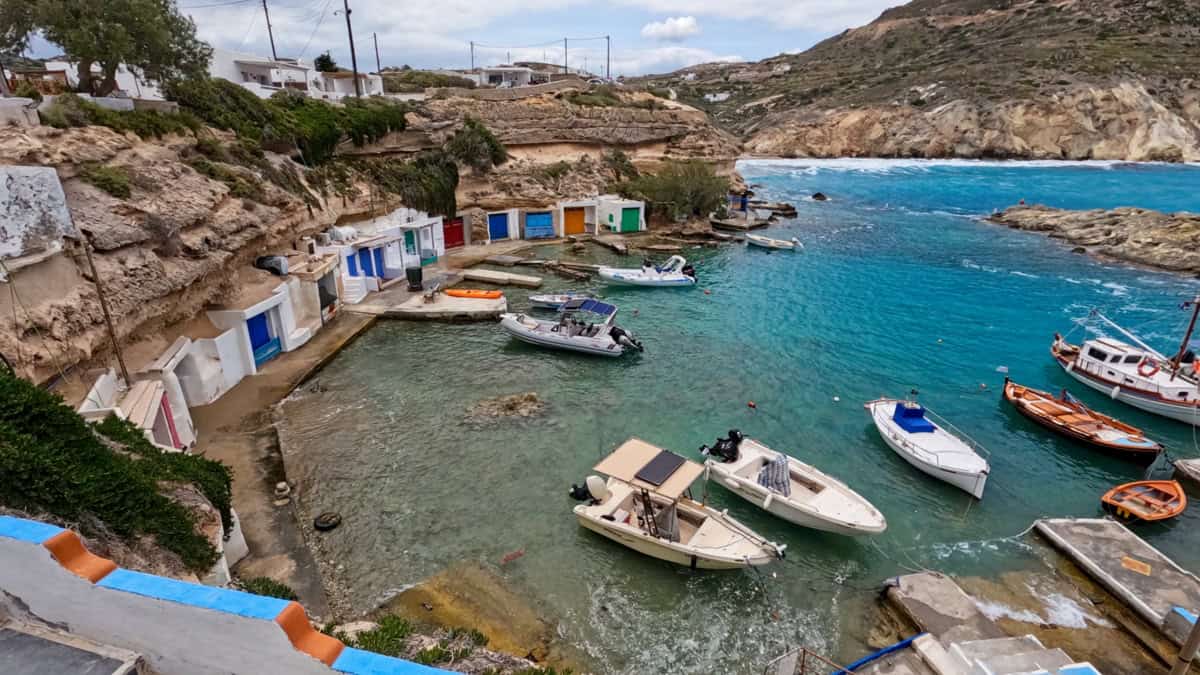
It’s most well-known for its single taverna, Medusa, which is reputedly one of the best fish restaurants on the island. Its walls are adorned with photos of celebrity customers such as Justin Bieber and Tom Hanks. We dined here on both trips to Milos, and it certainly lived up to our expectations. Given its captive market and reputation, it’s also not unreasonably priced, though tables are limited, so you may have to queue during busy periods.
Boat Tours
Our favourite and most highly recommended activity in Milos is a boat tour around the island’s exterior. On these tours, you can see its volcanic landscape and explore several stunning coves and beaches. We chose Milos Oniero for our tour and had an amazing full-day experience, including breakfast, lunch, and afternoon barbecue with all drinks included. There were several stops for swimming and snorkelling in secluded bays with equipment and towels provided. You can check out the Milos Oniero boat tour here, and you can also browse other tours on websites like Get Your Guide. Prices typically start at around €120 per person for full-day cruises, with cheaper half-day options also available.
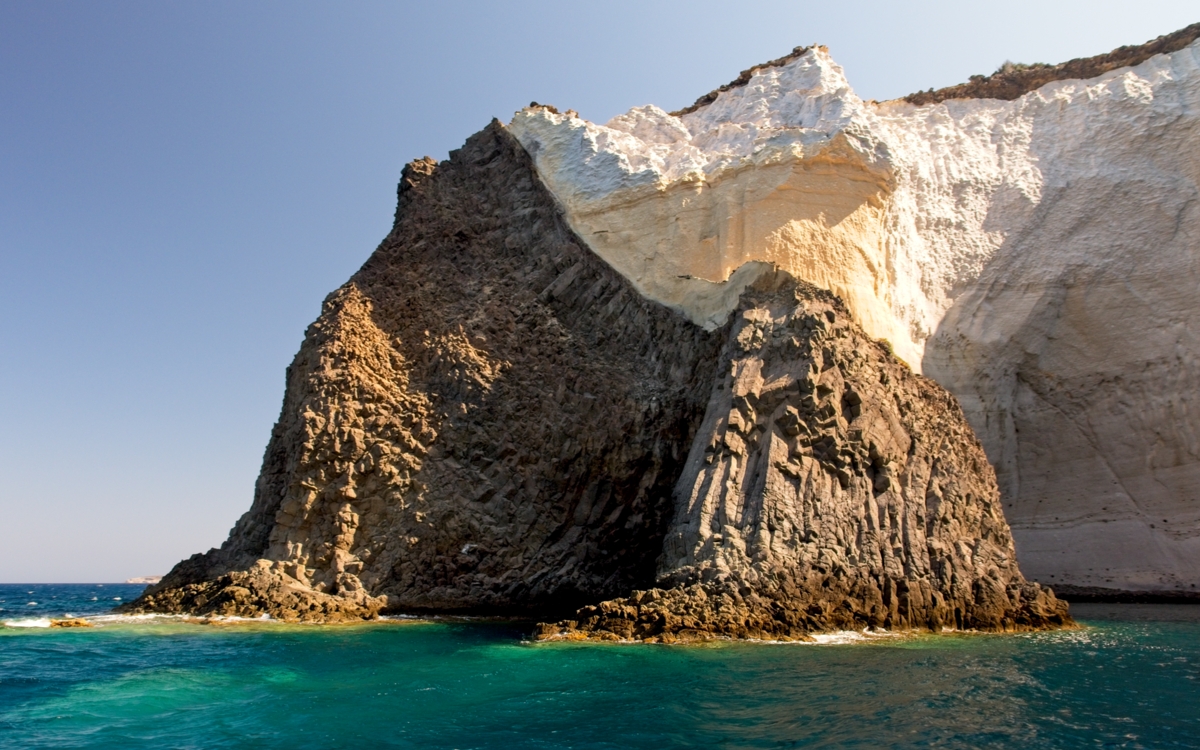
Papafragas Caves
On the northern coastline of Milos, just west of Pollonia, you’ll find Papafragas Caves. A series of deep cove bays eroded from the volcanic rocks offers a unique and picturesque spot for swimming and taking photos. Be aware that the area can be dangerous, and one of the small beaches is only accessible by walking down a steep and narrow rock wall. There is also limited shade during the middle of the day and no facilities, so it’s best experienced as a short stop on your way to or from Pollonia in the early morning or late afternoon.
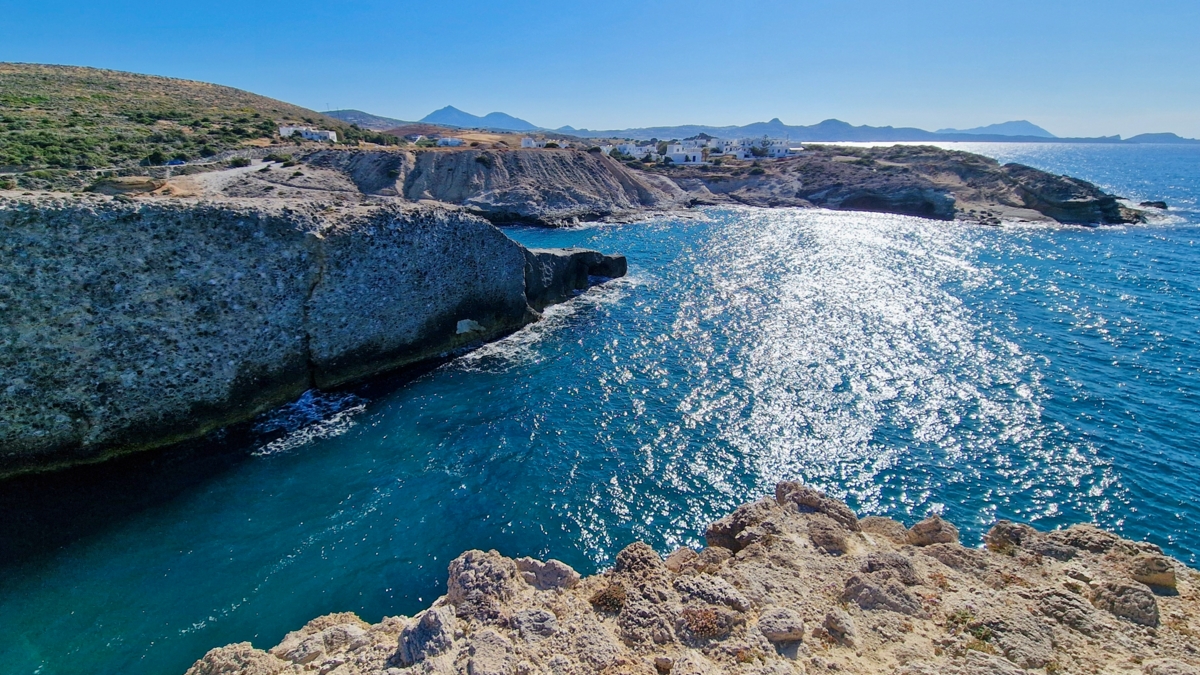
Visiting Kimolos
Kimolos is Milos’ closest neighbouring island, less than one kilometre from its nearest point off the northeastern tip. Although Kimolos offers a range of accommodation options, it’s most popular as a day-trip destination from Milos. A regular ferry links the islands via the small harbour in Pollonia to the port of Psathi on Kimolos’ southeastern side. The crossing takes just 25 minutes and costs €2.40 for passengers on foot. You’ll find a link to the Kimolos ferry timetable here.
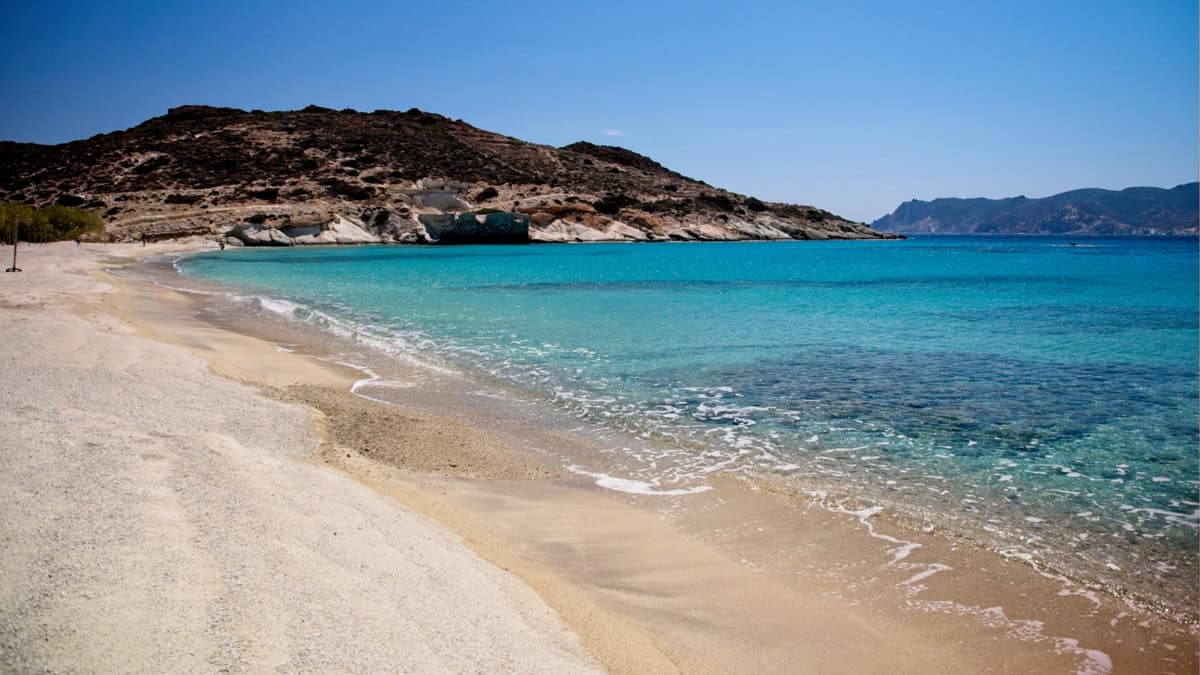
On our trip to Milos in May 2024, we spent most of a day on Kimolos, taking our e-bike across on the first ferry and returning at 4 p.m. During this time, we visited the stunning Prassa Beach on the northeastern coastline, one of the nicest we’ve seen anywhere in Greece. Its location feels remote, but due to the island’s small size, it only takes 15 minutes by car.
We also explored the peaceful and picturesque Chora, saw several other beaches along the island’s southern and western coastline and even managed an ambitious and sweat-inducing climb to Profitis Ilias, the highest point on Kimolos, with stunning panoramic views of the island’s rugged landscape.
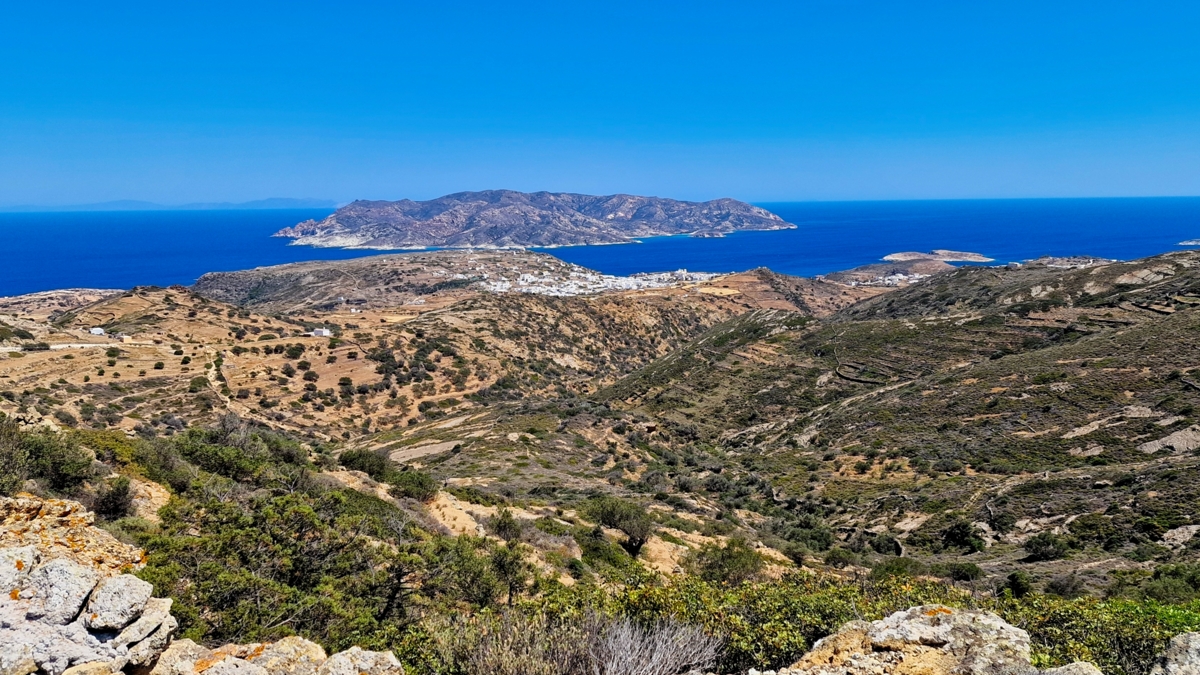
Milos Beaches
Milos boasts a good selection of beaches, many of which are sandy and offer shallow and calm water ideal for swimming or cooling off after sunbathing under the hot Greek sun.
Papikinou Beach
Conveniently located within walking distance of Adamantas, Papikinou Beach is a long, narrow stretch of soft sand with calm, clear water in the island’s sheltered bay. Often overlooked and therefore fairly quiet, it was one of our favourite spots during our first trip in 2020.
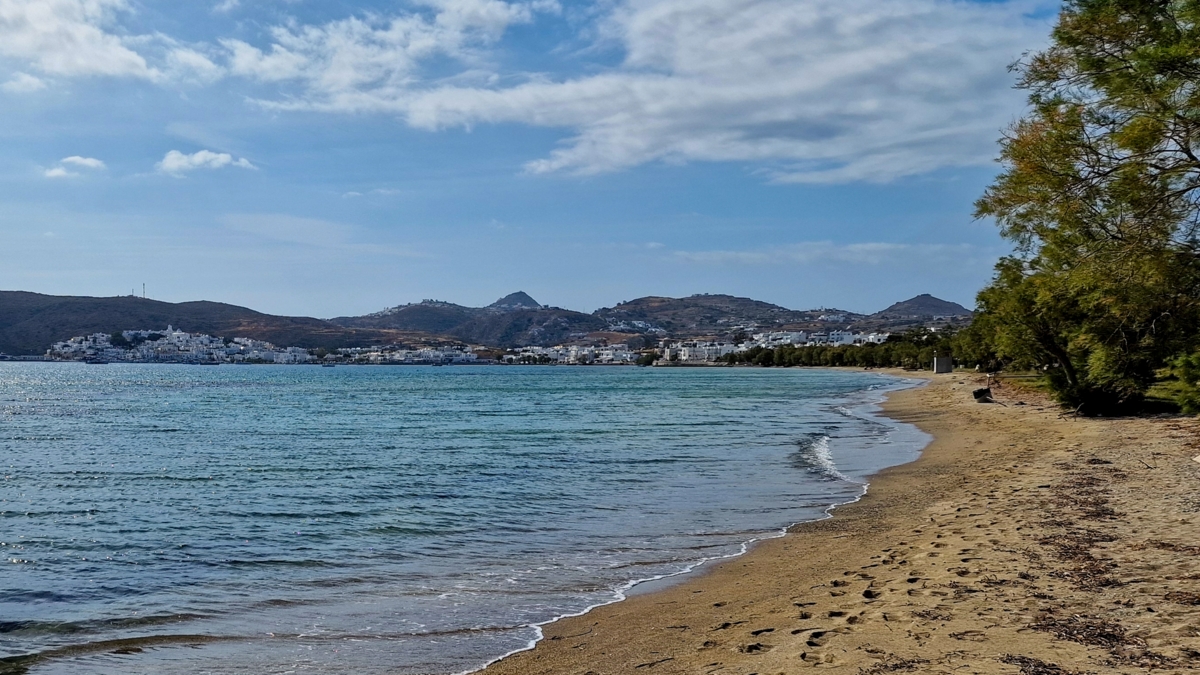
Firiplaka Beach
The second most famous beach after Sarakiniko, Firiplaka is a beautiful beach of soft, white sand and crystal-clear water on the south coast of Milos. In high season, sunbeds and a small beach bar offer comfortable sunbathing and refreshments, and a water sports centre offers paddle boards, snorkelling gear, and sea kayaks, as well as guided tours of the surrounding coastline. Although the beach is large, its popularity makes it prone to overcrowding in peak season, so it’s best to arrive early to secure your spot on the sand.
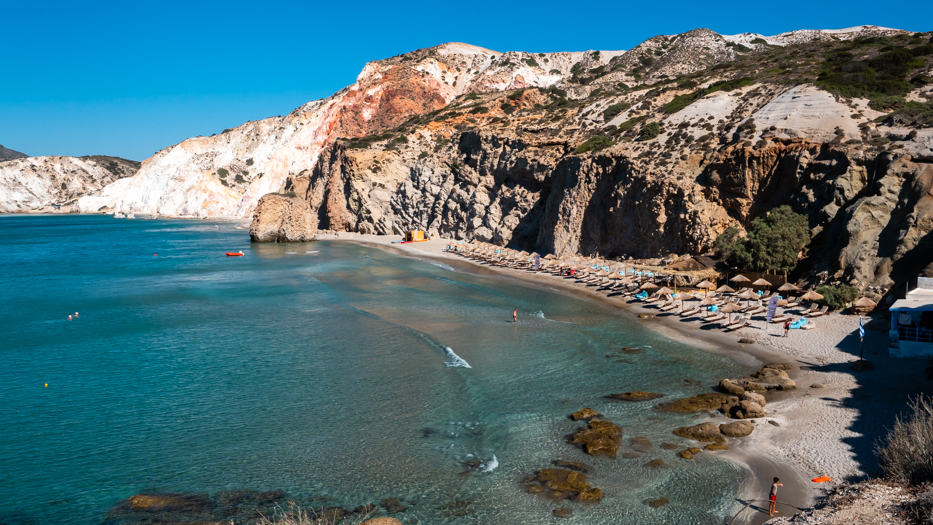
Tsigrado Beach
A short walk east of Firiplaka, Tsigrado is a small cove beach accessible by boat or via a wooden ladder down a very narrow crevice in the rock face. The beach is tiny and, due to its popularity, is easily overwhelmed. Consequently, we don’t recommend it except as a photo opportunity on your way to or from Firiplaka.
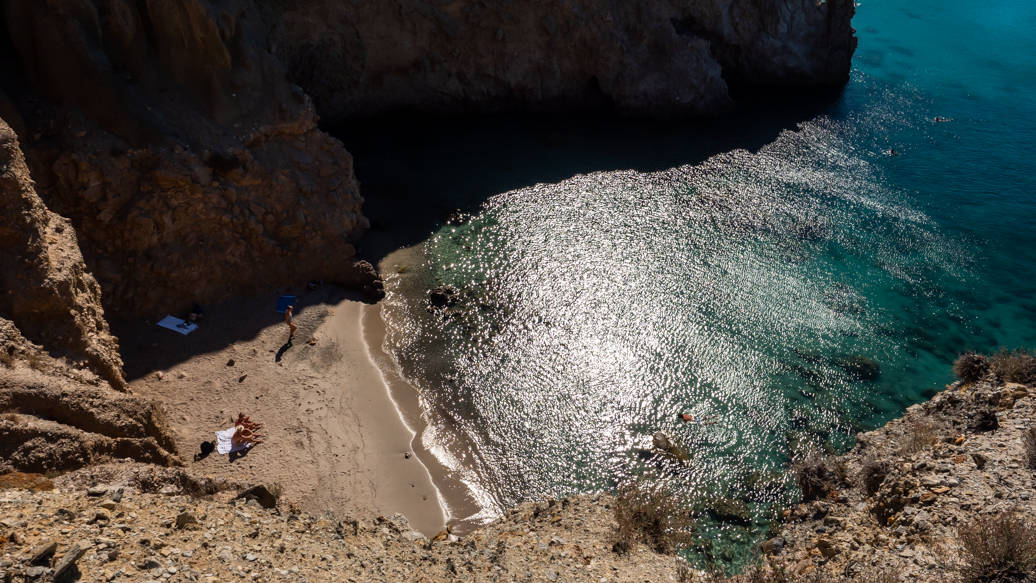
Achivadolimni Beach
Just past the airport in the Gulf of Milos, Achivadolimni is a long sandy beach with stunning views across the water towards Adamantas. The western end has a small beach bar with sunbeds, but most of the beach is undeveloped, with some natural shade provided by trees and the cliff face.
Although the sea is shallow, the beach is prone to high waves on windy days due to its north-facing position, making it popular for windsurfing.
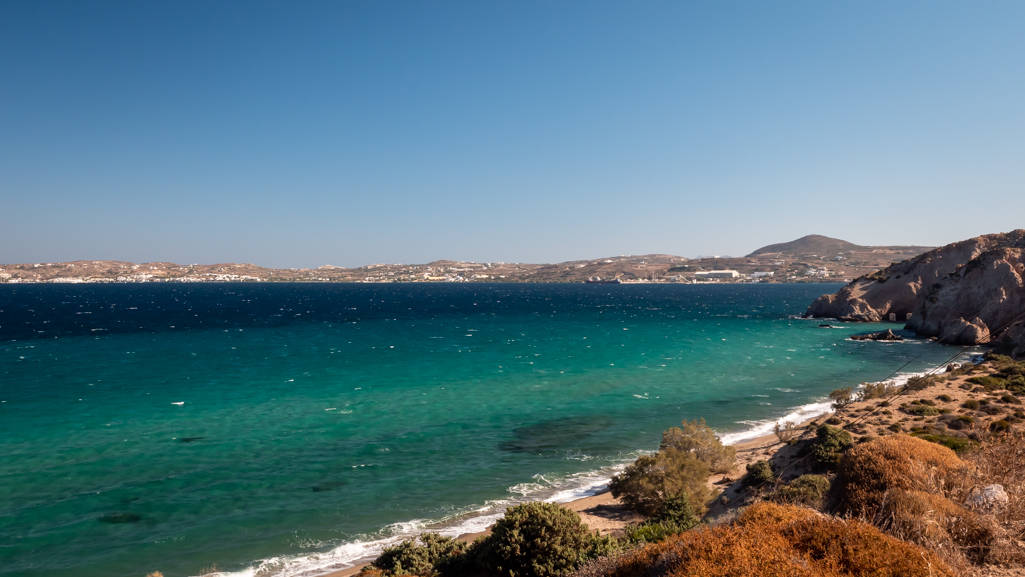
Lagada Beach
Situated in a quiet location just west of the port, Lagada is a small sandy beach offering sunbeds for rent and space to put down your own towel and relax close to the amenities of the nearby harbour. Although not the nicest beach on the island, it’s often overlooked and, therefore, less busy than you might expect given its location.

Plathiena Beach
One of Milos’ hidden gems, Plathiena is a secluded beach on the coastline northwest of Plaka. Inaccessible by public transport, we visited out of season in early May 2024 and didn’t think much of it, but as you can see in the photo below, it’s much more appealing on a sunny day and also makes for an excellent sunset spot due to its northwest-facing position.
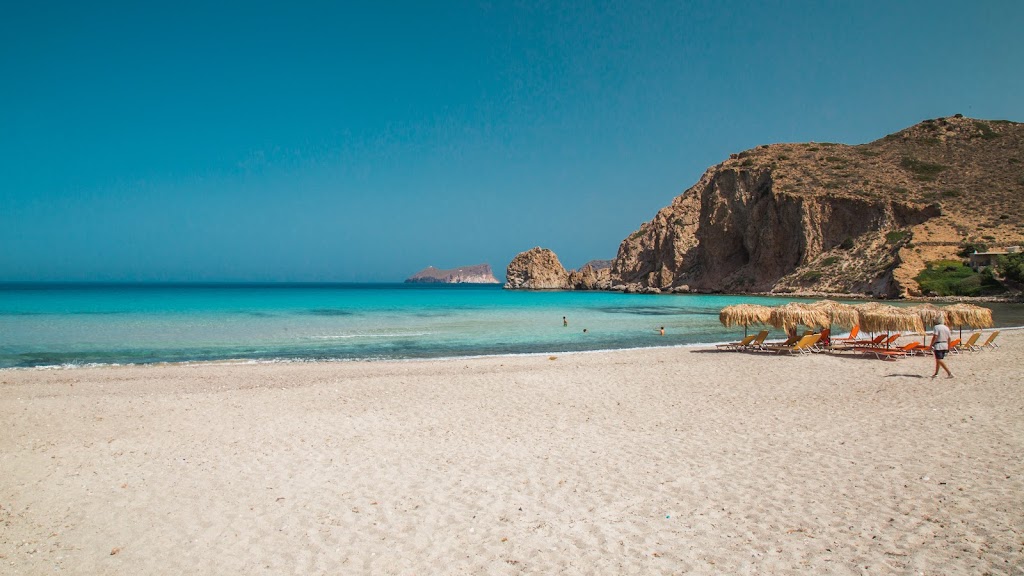
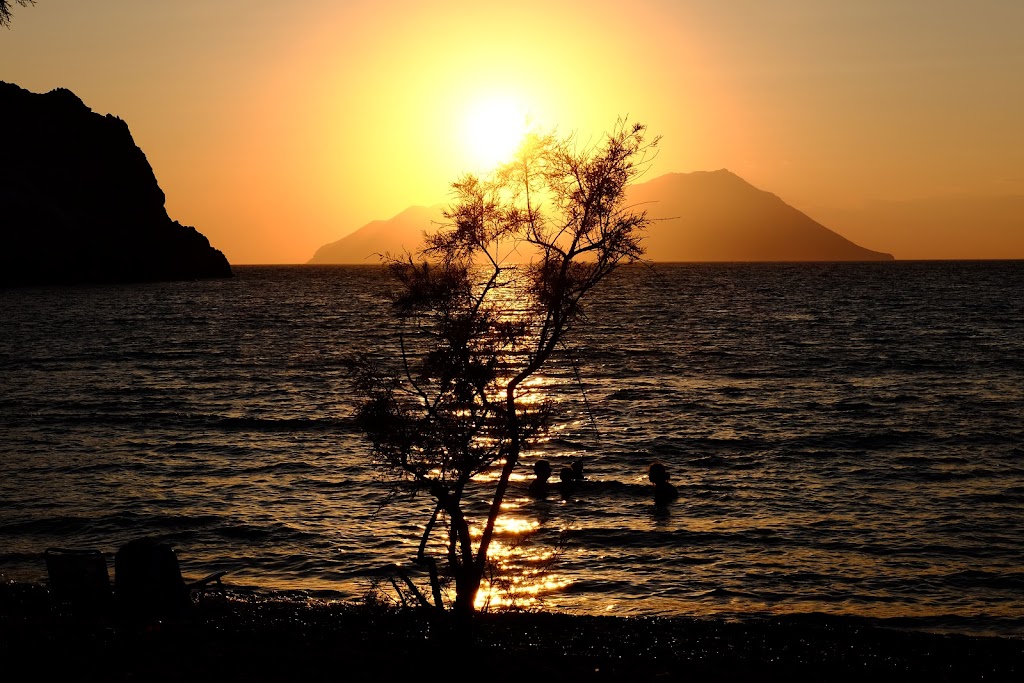
Pollonia Beach
As one of the most popular tourist destinations, Pollonia features a large, sandy beach in a wide east-facing bay. With a large car park opposite and close to nearby accommodation, cafes and harbourside tavernas, it’s a great family-friendly beach with a relaxed atmosphere and clear, calm water.
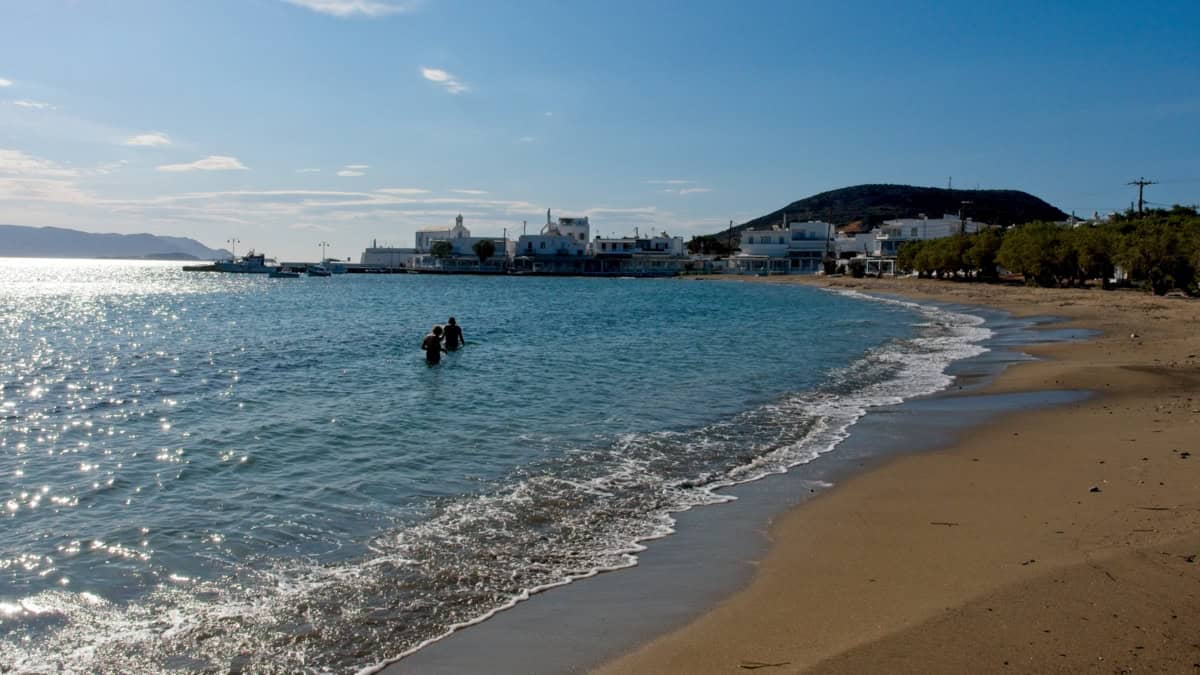
Accommodation
Milos offers various accommodation to suit every traveller, from charming boutique hotels to luxurious seaside villas and traditional Cycladic guesthouses. Whether you’re visiting for a romantic getaway, a family holiday, or a solo adventure, you’ll find plenty of options across the island.
Boutique Hotels and Luxury Stays
If you’re looking for stylish, design-led accommodations, Milos has an excellent selection of boutique hotels. Milos Breeze Boutique Hotel in Pollonia is a standout, offering sleek, minimalist rooms with private pools and panoramic sea views — perfect for honeymooners and couples. Nearby, Melian Boutique Hotel & Spa offers an intimate setting with luxurious amenities and an excellent spa for a touch of indulgence.
For a more private and exclusive experience, luxury villas like White Pebble Suites (also near Pollonia) blend understated elegance with spectacular coastal scenery.
Traditional Guesthouses and Studios
For a more authentic and budget-friendly experience, consider staying in a traditional Cycladic guesthouse. Hotel Delfini in Adamas offers simple, comfortable studios within easy walking distance of the port and town centre — ideal for first-time visitors. In Plaka, charming options like Villa Gallis give you a taste of local life, with whitewashed walls, flowering courtyards, and easy access to the village’s famous sunset viewpoints.
Beachside Stays
If waking up steps from the sea sounds appealing, Milos has several accommodations right on or near its famous beaches. In Pollonia, Nefeli Sunset Studios is a guest favourite, offering direct sunset views and a relaxed seaside atmosphere. For those wanting to stay closer to Sarakiniko’s dramatic white rock formations, Adamas provides a convenient base. Santa Maria Village offers a peaceful location near the beach with a large pool area and spacious rooms.
Below you’ll find links to reviews of hotels we’ve personally stayed at on Milos:
-
Hotel Delfini, Adamantas, Milos
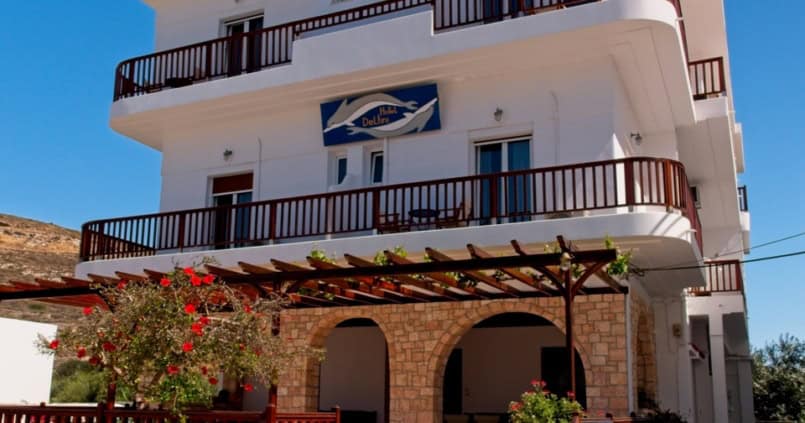
Review Rating: 4.5/5 Date of visit: May 2024 For my second visit to Milos, I wanted accommodation on a budget close to the port. Having previously stayed east of the…
-
Venus de Milo Studios, Adamas, Milos

Review Rating: 5/5 Date of visit: September 2020 As always, I took a fair amount of time choosing the right accommodation for the 5 nights I spent on Milos at…
Dining
Milos offers a delightful culinary experience that mirrors its natural beauty and rich cultural heritage. From traditional tavernas serving time-honoured recipes to modern eateries offering innovative twists on classic dishes, the island caters to a wide range of palates.
Traditional Flavours and Local Delicacies
At the heart of Milos’s dining scene are its traditional tavernas, where recipes are often passed down through generations. One such establishment is O! Hamos!, located at Papikinou Beach. This family-run taverna is renowned for its use of locally sourced ingredients, including meats and cheeses from their own farm. Dishes like slow-cooked lamb and homemade pitarakia (cheese pies) offer an authentic taste of the island’s culinary traditions.
Seafood by the Sea
Given its island setting, Milos boasts an abundance of fresh seafood. Astakas in the picturesque fishing village of Klima offers diners the chance to enjoy freshly caught fish and seafood dishes right by the water’s edge, making it a perfect spot for a romantic sunset dinner.
In Mandrakia, Medusa is a must-visit for seafood enthusiasts. Known for its octopus dishes and traditional Greek salads, this taverna provides a serene dining experience with views of the quaint fishing village. It’s had several celebrity endorsements, too, with photos of actor Tom Hanks and musician Justin Bieber adorning its walls!
Modern Twists and Innovative Cuisine
For those seeking a contemporary dining experience, Sirocco on Paleochori Beach offers a unique culinary adventure. Utilising the island’s volcanic activity, some dishes are cooked in the sand, providing a distinctive flavour and presentation.
In Pollonia, Enalion stands out with its fusion of traditional Greek flavours and modern culinary techniques. Dishes like sea urchin pasta and shrimp saganaki showcase the chef’s creativity and commitment to fresh, local ingredients.
Sweet Treats and Cafés
No culinary journey is complete without indulging in some sweet delights. Kivotos ton Gefseon in Pollonia is a charming patisserie known for its delectable pastries, including chocolate and orange pies. It’s an ideal spot for a morning coffee or an afternoon treat.
Tips for Dining in Milos
- Reservations: During the peak tourist season (July and August), it’s advisable to make reservations in advance, especially for popular restaurants.
- Local Specialities: Don’t miss out on trying local dishes like karpouzopita (watermelon pie) and skordolazana (garlic-flavoured pasta).
- Meal Times: Greeks typically dine later in the evening, so restaurants may be quieter earlier in the night.
- Cash and Cards: While many establishments accept credit cards, it’s a good idea to carry some cash, particularly when visiting smaller tavernas.
Whether you’re savouring traditional dishes in a rustic taverna or exploring modern culinary creations by the sea, dining in Milos is an experience that tantalises the taste buds and leaves lasting memories.
Top Tips for Milos
- Take a boat tour: If we haven’t mentioned it enough already, the all-day boat tour we took during our first visit to Milos in 2020 was one of our standout Greek experiences. We were captivated by the unique rock formations, hidden coves, and secluded beaches. It was an unforgettable adventure, and we recommend it to anyone planning a trip to Milos.
- Visit Kimolos: Like Antiparos and Paros, Kimolos’ close proximity to its more famous neighbour makes it a popular day-trip destination for those looking to get the most out of their vacation. The cheap and regular ferry service makes it easy to hop across and explore the delights of this quieter and more traditional Greek island. We thoroughly enjoyed our time on Kimolos and think it’s well worth including in your itinerary.
- Hire a vehicle: Although Milos’ bus network has improved in recent years, it still lacks the coverage and frequency you’ll need to explore the island effectively. Renting a car, bike, or ATV for a day or two will ensure you see all the sights on your own timetable and is well worth it, particularly for the stunning sunset views from Plaka and nearby villages.
- Use internal flights to get to/from the mainland: If you’re travelling to Milos from Athens or heading back to the mainland at the end of your trip, we highly recommend considering internal flights as an alternative to ferries. The cost is often comparable, and the time saved with a short 30-minute flight, which avoids transfers to and from the busy port of Piraeus, can easily justify the additional expense.
- Avoid Western Milos: Though it can be tempting to get ‘off the beaten track’ and venture over to the western side of Milos, there’s very little worth seeing, and you could be wasting valuable time that is better devoted elsewhere. We spent 45 minutes riding an ATV across bumpy dirt roads just to see the monastery on the western coastline and nearby beaches, but we felt it was disappointing and wouldn’t recommend it.
Milos Videos
Milos Frequently Asked Questions (FAQs)
Here are some of the most frequently asked questions about Milos:
Milos is a volcanic island in the Cyclades group of the Aegean Sea, situated southwest of mainland Greece, near Sifnos and Folegandros.
You can reach Milos by ferry from Athens (Piraeus port) or other Cycladic islands like Santorini and Mykonos. Milos also has a small airport with daily flights from Athens.
Milos is famous for its stunning beaches (over 70 of them!), its unique volcanic landscapes like Sarakiniko, colourful fishing villages like Klima, and being the discovery site of the Venus de Milo statue.
The best time to visit Milos is from late May to early October. July and August are the busiest months, while June and September offer great weather with fewer crowds.
Top highlights include Sarakiniko Beach, Kleftiko Caves (accessible by boat), the Catacombs of Milos, Plaka village for sunset views, and the fishing village of Klima.
Yes, renting a car, ATV, or scooter is highly recommended. Public transportation is limited, and many of the best beaches and sights are easier to reach with your own vehicle.
Plan for at least 3 to 4 days to fully explore Milos’s beaches, villages, and main attractions without rushing.
Popular beaches include Sarakiniko, Firiplaka, Tsigrado, Paleochori, and Agia Kiriaki. Each offers a different experience, from dramatic cliffs to colourful sands.
Yes, Milos is great for families. Many beaches have calm, shallow waters perfect for children, and the island has a relaxed, safe atmosphere.
Milos is generally more affordable than Santorini and Mykonos, but prices can be higher during the peak summer months. Good-value accommodation and dining options are available.
Milos specialises in fresh seafood and local dishes like pitarakia (small cheese pies) and karpouzopita (sweet watermelon pie). Many restaurants use ingredients sourced directly from the island.
Yes, boat tours are a highlight of visiting Milos. Tours typically circle the island or explore the Kleftiko Caves and nearby beaches, allowing swimming in stunning, remote spots. We recommend Milos Oniero.
Definitely. Milos has several scenic hiking trails, particularly around Plaka, Klima, and to remote beaches. The landscape combines volcanic rock, sea views, and classic Cycladic scenery.
Yes, English is commonly spoken in hotels, restaurants, and tourist areas, though learning a few basic Greek phrases is always appreciated! Try ‘Kalimera‘ for good morning, ‘Kalispera‘ for good afternoon/evening, ‘Yiasas‘ for hello, and ‘Efharisto‘ for thanks!
Milos offers a quieter, more laid-back experience compared to Santorini. While it may not have Santorini’s iconic caldera views, it more than makes up for it with its beaches, natural beauty, and authentic vibe.
Milos: Conclusions and Alternatives
Although Milos certainly offers plenty of Cycladic charm—with a wide variety of beaches, good food, and excellent accommodation options—its growing reputation can sometimes set expectations at a level the reality doesn’t always meet. Having visited twice, once in 2020 and again in 2024, we had an enjoyable time (as we do on nearly all Greek islands), but left feeling that Milos didn’t quite live up to the considerable hype.
Sarakiniko Beach, one of the island’s most famous sights, is undoubtedly striking and unique. However, it’s not necessarily an ideal place to relax for long periods. The dramatic white rock landscape makes for memorable photos, but lying on bare stone isn’t as comfortable as the classic golden-sand beaches many visitors might expect. The sea here, due to its northern exposure, can also be quite rough—something we experienced on both visits.
That said, Milos still has plenty to offer. A boat tour around the island is a real highlight and highly recommended for its access to otherwise unreachable coves and stunning cliffs. Visiting the Catacombs and exploring the island’s inland villages are also rewarding experiences that showcase a quieter, more authentic side of Milos.
For seasoned travellers to Greece or those with extra time in their itinerary, Milos is certainly worth considering. However, if you’re choosing it as your primary destination, or as an alternative to busier islands like Santorini or Mykonos, it’s worth comparing your options. Nearby islands such as Sifnos, Folegandros, and Serifos, in our view, deliver more consistently on the promise of an unspoiled ‘hidden gem’ experience.
Milos Blog Posts
Find out more about Milos by reading our recent blog posts:
-
Milos Day 6: Adamas, Milos Airport, Athens Flight Home
This post is part of a series called Santorini, Milos and Kimolos 2024 Monday 13th May 2024 Last Day of the Trip The final day of my trip had arrived….
-
Milos Day 5: Pollonia, Kimolos Day Trip, Papafragas Caves, Adamas
This post is part of a series called Milos and Kimolos 2024 Sunday 12th May 2024 The Sun is Shining! I woke at 7 a.m. to my early alarm, keen…
-
Hotel Delfini, Adamantas, Milos
Review Rating: 4.5/5 Date of visit: May 2024 For my second visit to Milos, I wanted accommodation on a budget close to the port. Having previously stayed east of the…
-
Milos Day 4: Catacombs, Ancient Theatre, Klima, Mandrakia and Sarakiniko
This post is part of a series called Santorini, Milos and Kimolos 2024 Saturday 11th May 2024 A cloudly breakfast in Adamas I woke early after a good night’s sleep,…
-
Catacombs of Milos
Introduction Hidden beneath the surface of the idyllic Greek island of Milos lies a fascinating secret: the Catacombs of Milos. These ancient burial chambers, carved into the volcanic rock, offer…

